Green shiny beetles are seen in growing habitats across North America. They are common on the West Coast, in Northeastern habitats, and in the Mid-West.
A growing number of shiny beetles are adapted to living in various temperate and sub-tropical climates which means many species can live in almost any part of the world as well.
These beetles can exclusively feed on plants. Some are scavengers while others are omnivores. A few native green shiny beetles of North America are also known for eating feces and carrion.
A wide range of green tiger beetles is also known for feeding on bark and trees. These types of green shiny beetles can be highly detrimental to tree health.
Citruses and oak trees are among the most affected species in North America.
Green beetles can also have a reduced impact on trees and vegetation, depending on their species.
In terms of coloring, most green shiny beetles in the US are either light green or dark green with a shiny appearance.
A small number of these beetles have a multicolored body where green is combined with white, red, or yellow in most instances, especially on the elytra.
The following species of beetles have a green shiny body as a dominant trait or as a rare morph.
Table of Contents
1. Japanese Beetle
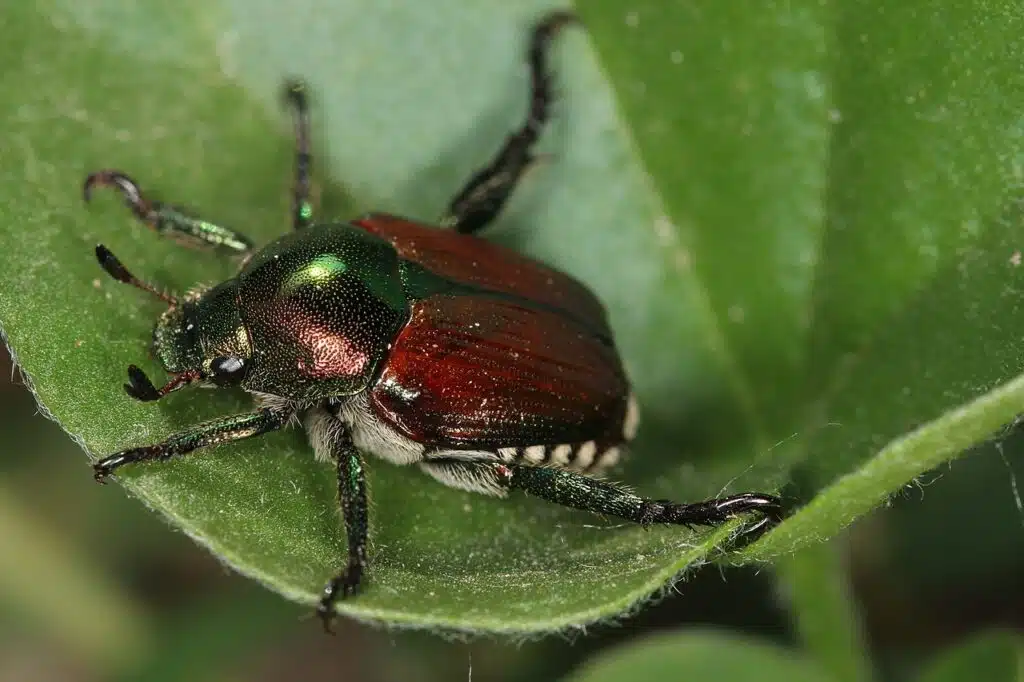
The Japanese beetle (Popillia japonica) is imported from Japan. Unlike its native Japanese counterpart, this beetle creates large problems in the US where it eats vegetation without as many predators.
This species has copper-like elytra and a shiny green almost metallic thorax and head.
It also has black and white spots around its elytra which makes this multicolored beetle easy to identify.
Growing up to a size of 15mm, this beetle is very good at eating entire plant leaves. Only its veins remain untouched.
It lays eggs in the ground and the emerging Japanese beetle starts chewing on plant roots for food.
2. Six-spotted Tiger Beetle
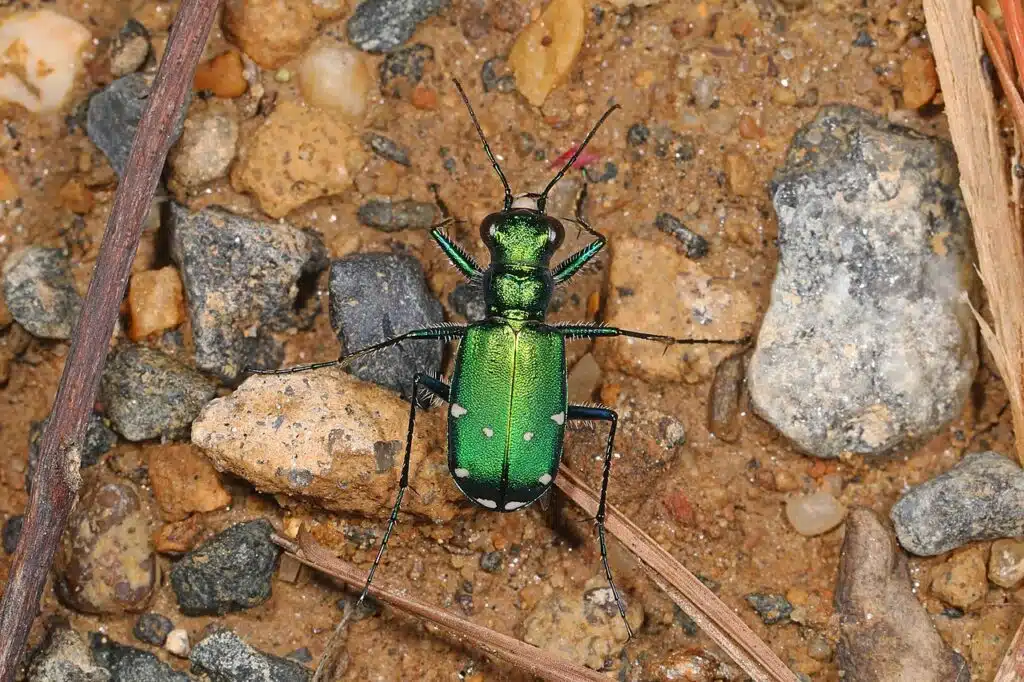
The Six-spotted Tiger beetle (Cicindela sexguttata) is one of the shiniest green beetles found in North America.
Its body is completely metallic glossy green. It has large white mandibles which means the species is distinct and easy to identify.
This beetle is a known predator. It feeds on almost all small arthropods and includes spiders and caterpillars.
While present in all types of habitats, these beetles prefer sandy terrain to lay eggs in easier.
Growing to a size of at least 12mm, these beetles can be seen in open areas with plenty of sunlight. They are only seen in groups in areas with plenty of food.
3. Common Green June Beetle
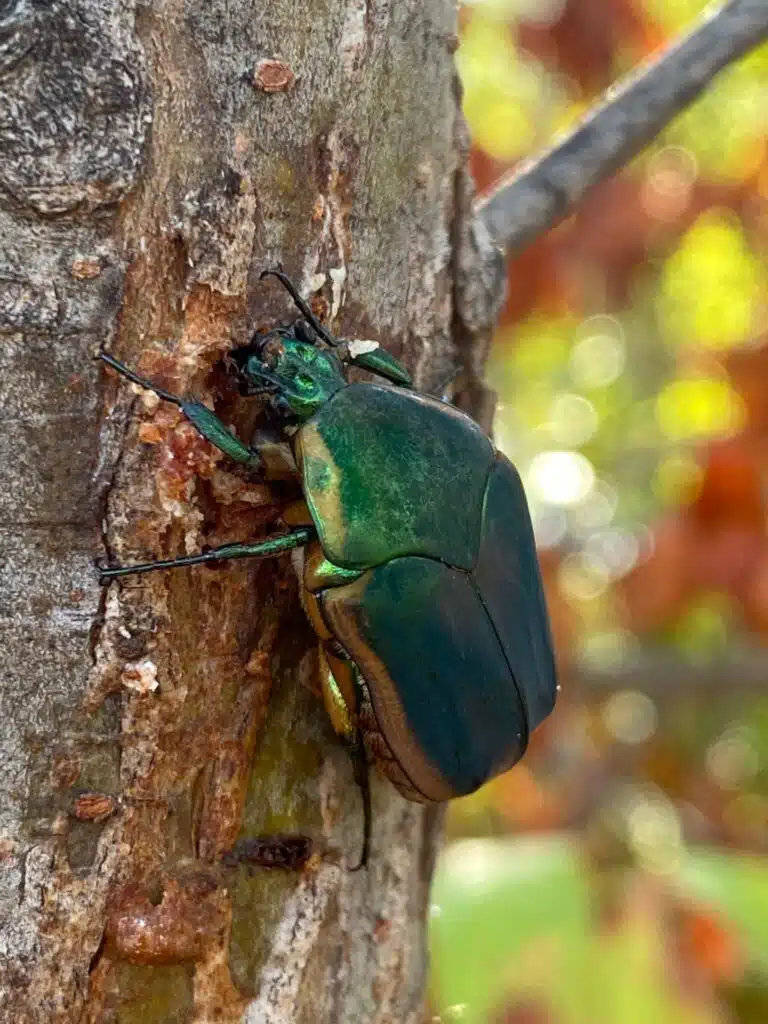
The Common Green June beetle (Cotinis nitida) is a common green shiny beetle in states such as Georgia.
Beetles of this genus are only partially green as half of their body has a dark gold color.
The specie is known to feast on foliage. Unlike other beetles, this species also eats the veins of leaves practically leaving nothing behind.
Growing up to a size of 40mm, the species can be controlled with pesticides, especially since it emerges late in the season.
Common Green June Beetles only appear in the second part of June. This leaves sufficient time for gardeners and farmers to take preventive measures.
4. Dogbane Leaf Beetle
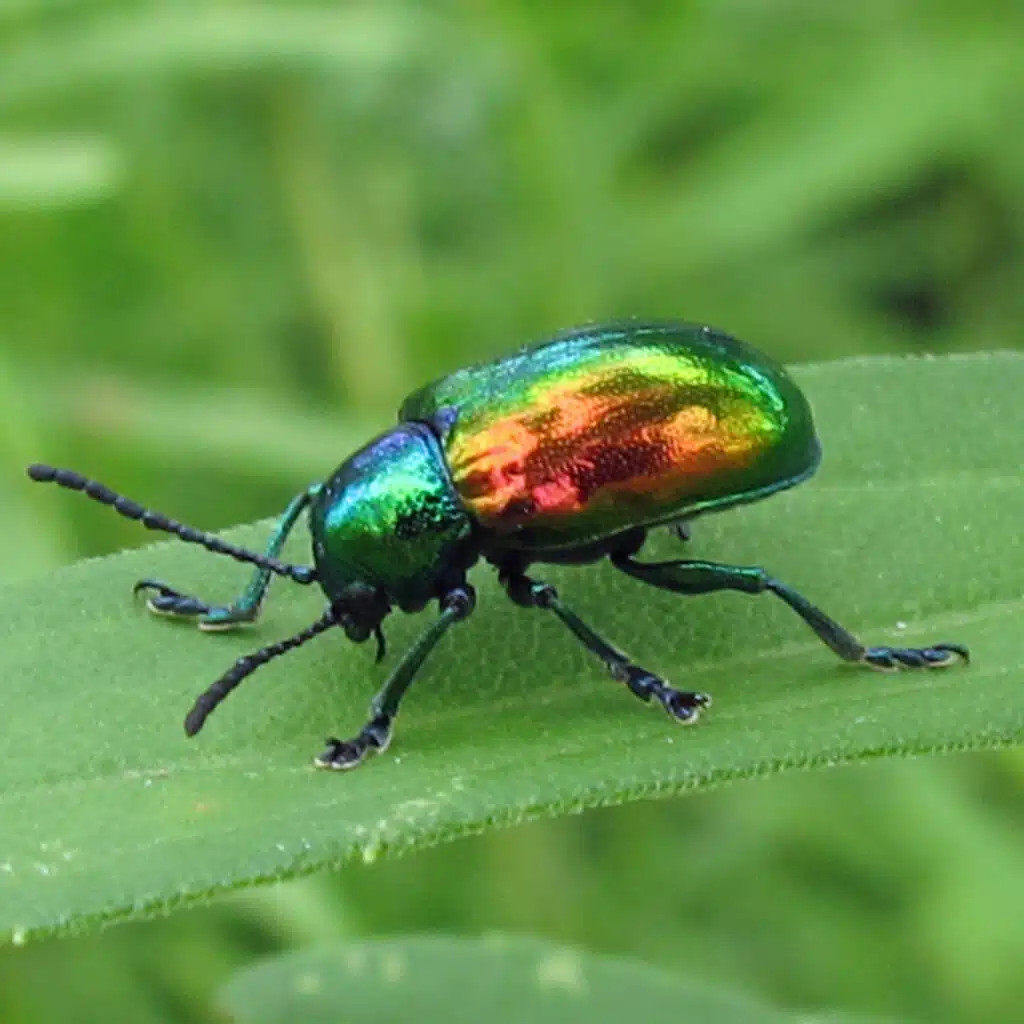
Dogbane Leaf beetles (Chrysochus auratus) get their names from their exclusive food, dogbane. Common in the Northwest, this species has a metallic shiny body.
The body has a shiny green nuance with iridescent reflections in direct sunlight. It can appear golden in certain spots depending on how light reflects off its body.
Bugs of this genus are toxic and many predators avoid them due to their bad taste and toxic nature.
They live on plants that are rich in toxins. They eat and absorb these toxins also storing them in the body so that a limited amount of natural predators would even consider attaching them.
5. Figeater Beetle
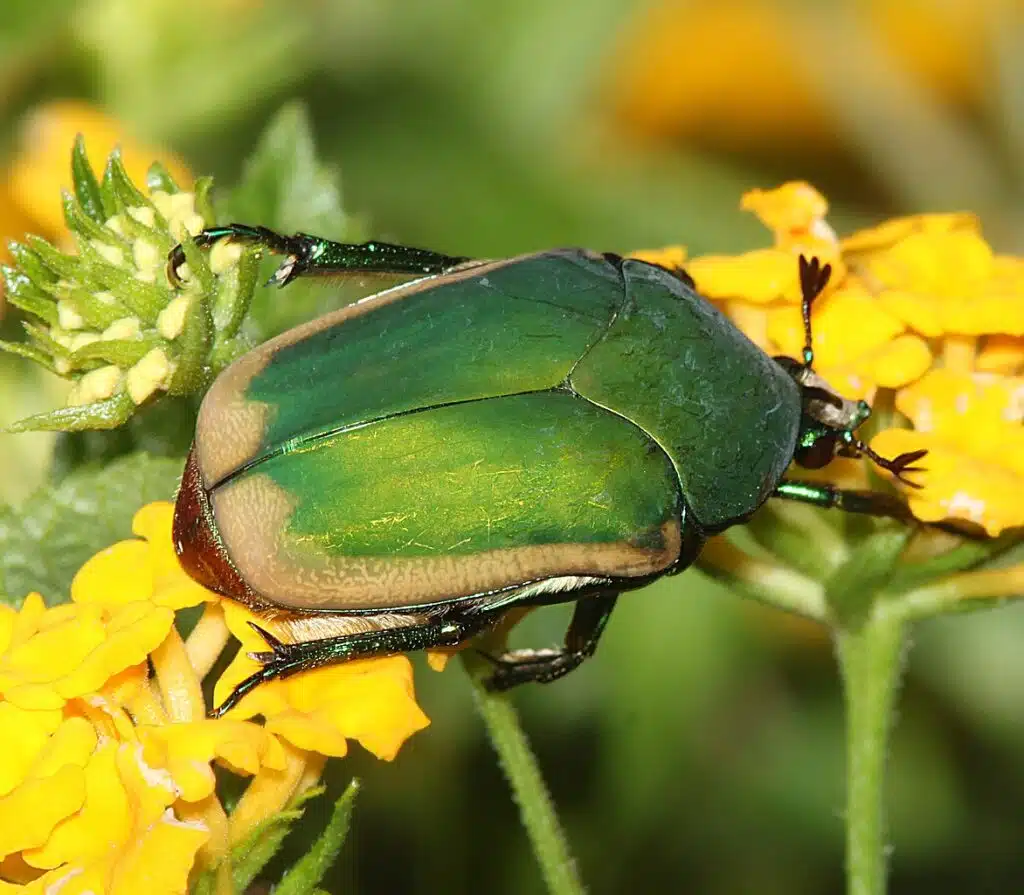
Figeater beetles (Cotinis mutabilis) have a dark green body with yellow bands on the sides of the elytra.
Bugs of this genus are common in Southwestern US. It’s also seen in gardens where it’s not seen as a major threat.
In extreme cases, this beetle has been responsible for devouring entire crops of fruit. It has been noted to eat grapes.
However, the Figeater beetle is mostly known for drinking sap from cacti and desert-loving trees.
It’s not seen as a major pest as it doesn’t mainly invade flowers in the garden or the lawn.
6. Fiery Searcher Beetle
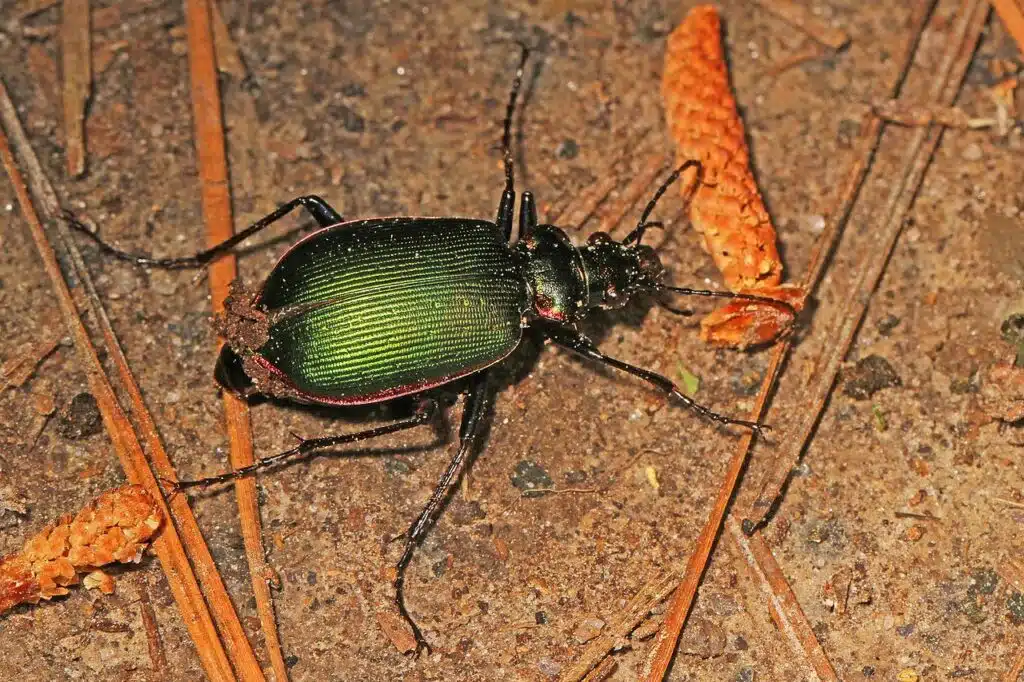
The Fiery Searcher beetle (Calosoma scrutator) has a shiny uniform green elytra and a blue cephalothorax.
These are some of the most helpful types of green beetles in the world as they consume a wide range of pests.
They are known for eating moths and destructive caterpillars on crops and gardens.
Fiery Searcher beetles have a large body (often larger than 30mm) and long mandibles they can use against a wide range of insects.
Furthermore, these beetles also release strong chemicals which help keep some predators away. Other predators such as birds and shrews are known not to be deterred by these strong chemicals of the Fiery Searcher beetle.
7. Emerald Ash Borer
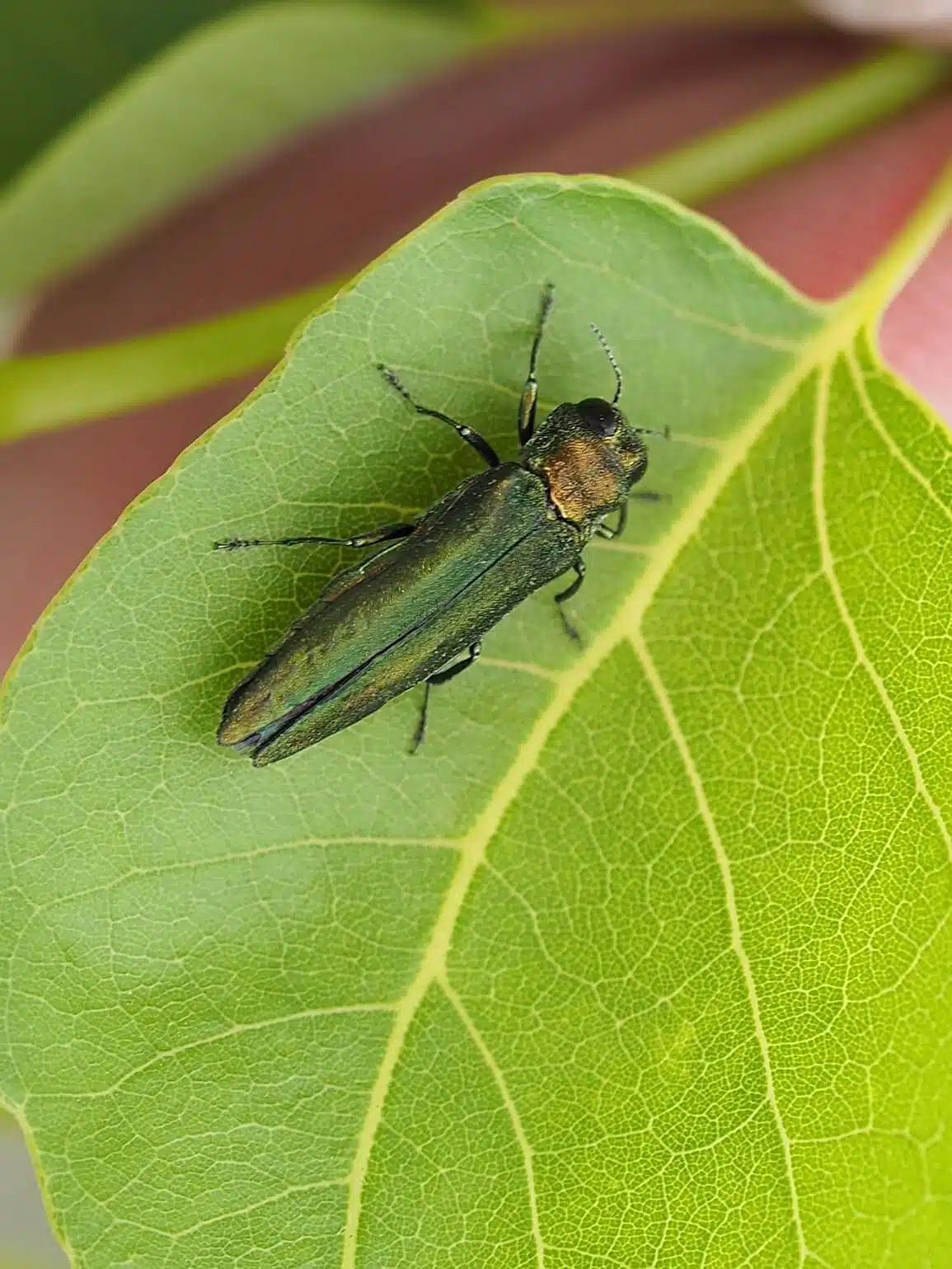
Emerald Ash Borers (Agrilus planipennis) have a metallic shiny uniform green body. These elongated borers are some of the most problematic bugs in the world of North America ash trees.
Most ash trees in North America are considered possible victims of this beetle and its expanding range.
Common in North America only for a few decades, beetles of this genus get under ash tree bark which they eat and lay eggs in.
With significant damage, ash trees start to die.
There’s little that can be done against these beetles they normally affect ash trees in the first 10 years of their lives which means they don’t yet reach their natural seeding age.
These beetles are known to attack young ash trees and their expanding range is a sign of trouble for green and black ash.
8. Rainbow Scarab
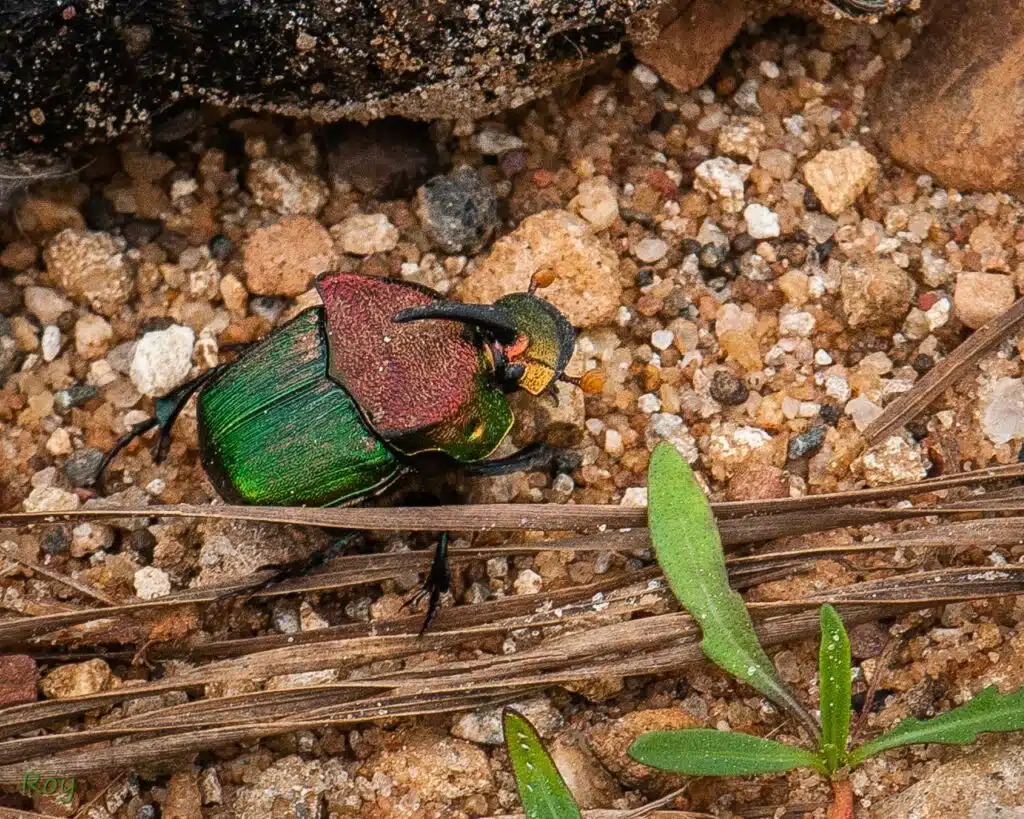
The Rainbow Scarab (Phanaeus vindex) has a shiny green color with yellow-brown nuances on the thorax.
Beetles of this genus are instantly-indefinable by their longhorn.
Found in Eastern US states, the Rainbow Scarab is a species known to eat animal dung. As a result, it should be avoided when it comes to direct handling as it can carry parasites.
Rainbow Scarabs eat all types of dung such as those of pigs, opossums, and dogs.
9. Green Immigrant Leaf Weevil
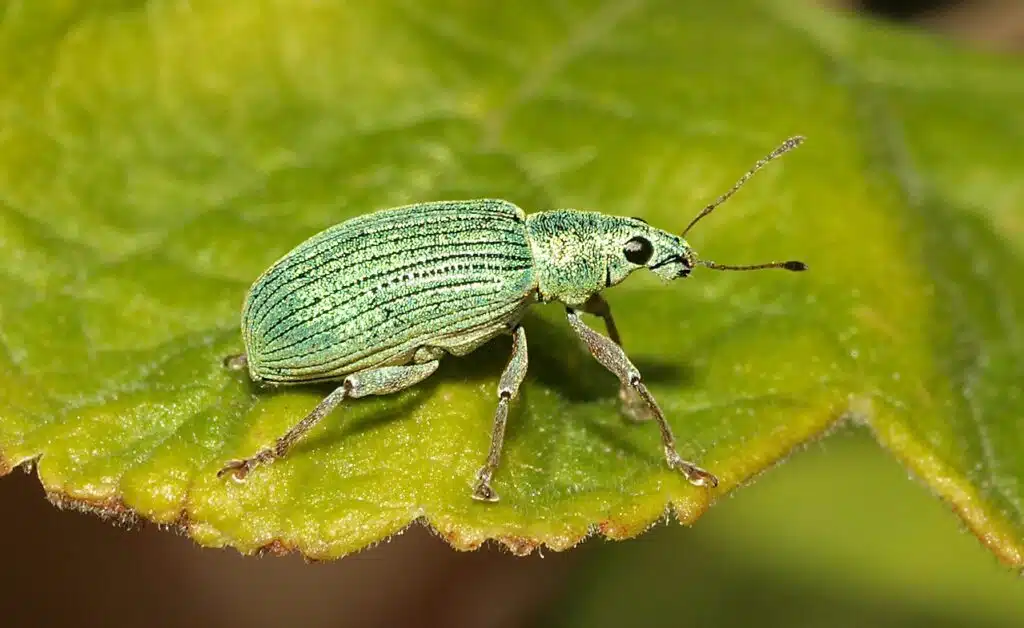
The Green Immigrant Leaf weevil (Polydrusus formosus) is a common species in temperate climates.
It has a vivid green or green-blue body with a central blue stripe on the elytra. The top of its head and its elongated snout are black.
Weevils of this genus are known for their damaging role to various leaves and should be removed when seen on trees in the backyard.
Hazel and oak trees are among the most exposed species to the impact of this species.
Green Immigrant Leaf weevils eat leaves entirely slowing down and even stopping the natural photosynthesis process of various hardwood trees.
10. Asian Oak Weevil
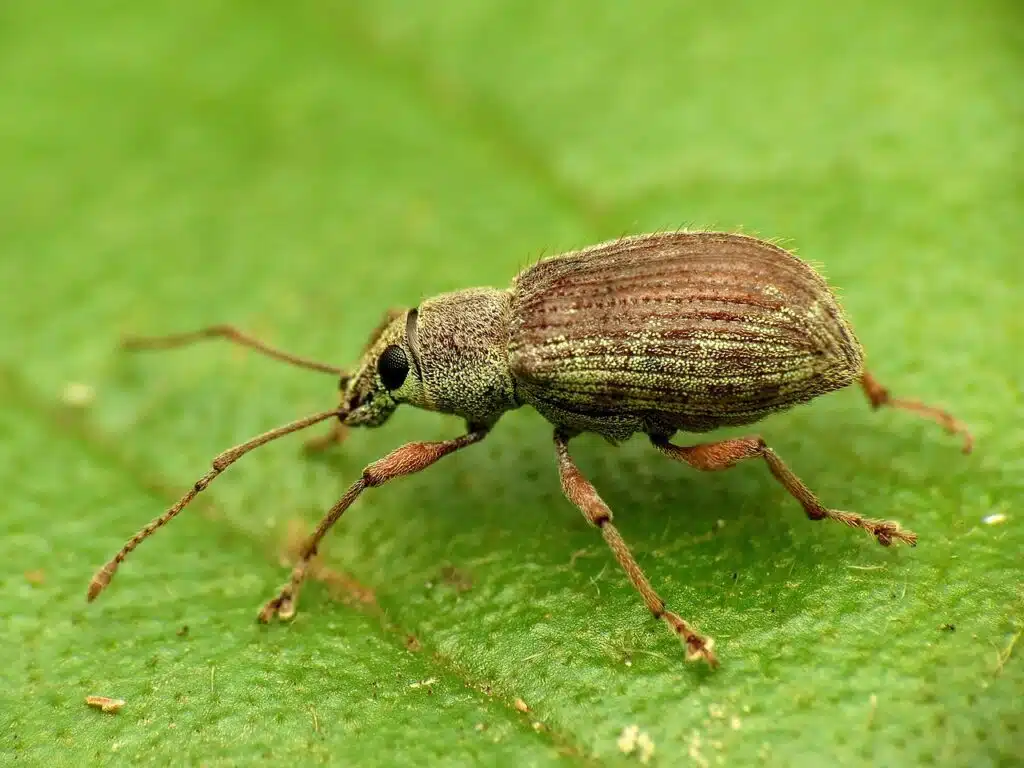
The Asian Oak weevil (Cyrtepistomus castaneus) has a uniform green color with visible grooves on the elytra.
The coloring of this species closely resembles the color of the oak leaves it lives on and which it consumes.
This type of weevil impacts oak trees and other species of trees such as chestnuts.
Its impact can be major but many measures can eliminate it or prevent it.
Insecticides are successfully used against these weevils and they can be applied as preventive measures on young trees as well.
Red oak and black oak trees tend to be the most affected by the species so it’s best to take extra caution when it comes to protecting these species.
11. Golden Buprestid Beetle
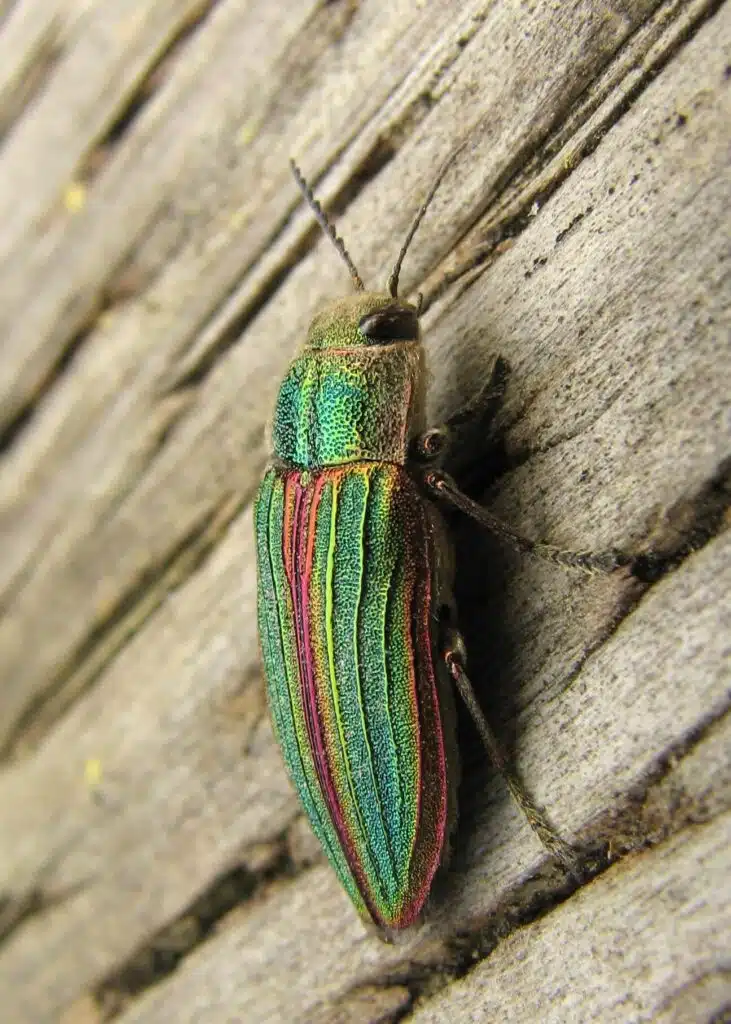
The Northwestern US territories are home to the Golden Buprestid beetle (Buprestis aurulenta).
Beetles of this genus have a golden green color with silver shiny overlays.
The species has a golden color which can change its nuance in direct sunlight. It can also appear purple or even brown in certain light conditions.
These beetles are mostly interested in eating hardwood. They even nest in hardwood trees.
Most beetles of this genus lay their larvae in the bark of many coniferous trees. These trees are mostly found on the Pacific Coast and they expand their range through Western Canada.
The species can be of high risk to trees which it can kill in time.
12. Splendid Earth-boring Beetle
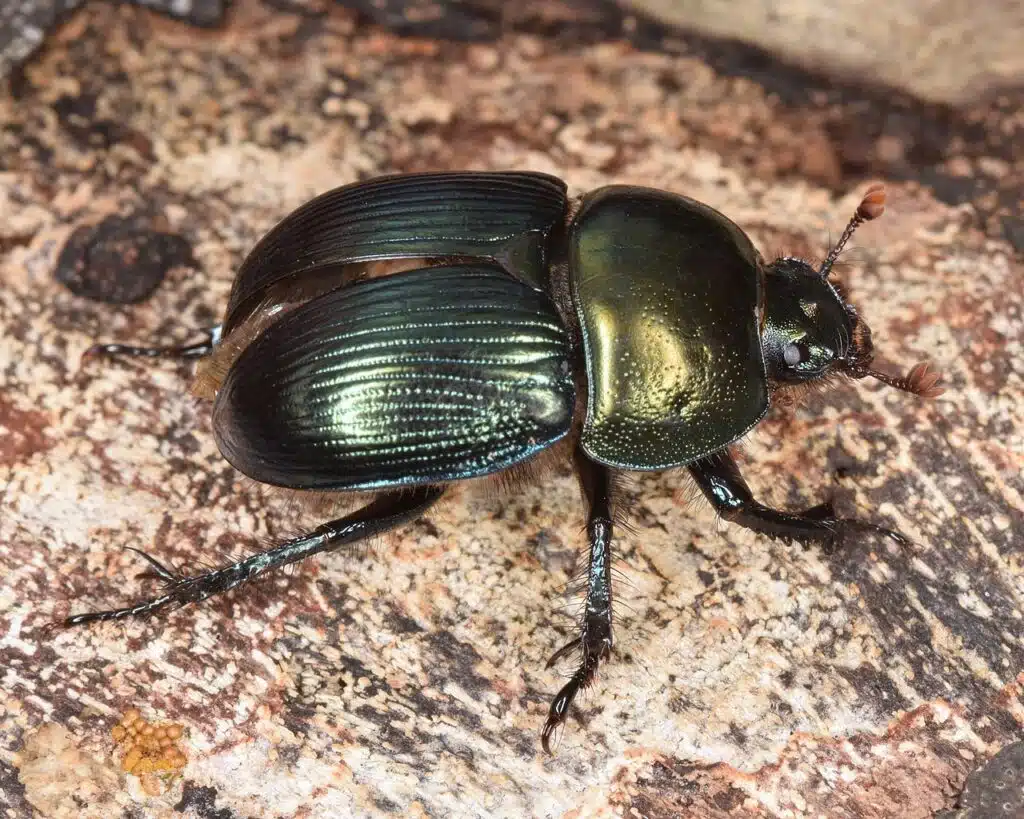
The Splendid Earth-boring beetle (Geotrupes splendidus) has a dark glossy green color.
It grows up to 0.5 inches and it has a round shape compared to other glossy green beetles.
This beetle can sometimes appear black and other times it comes with a golden iridescent hue.
Beetles of this genus are omnivores and scavengers. They eat a wide range of food and leftovers such as carrion and feces. Splendid Earth-boring beetles even eat bird feathers.
The species appear in the spring, soon before the end of March.
Beetles of this genus soon become adults and are ready to lay eggs deep in the ground.
13. Flower Lebia Beetle
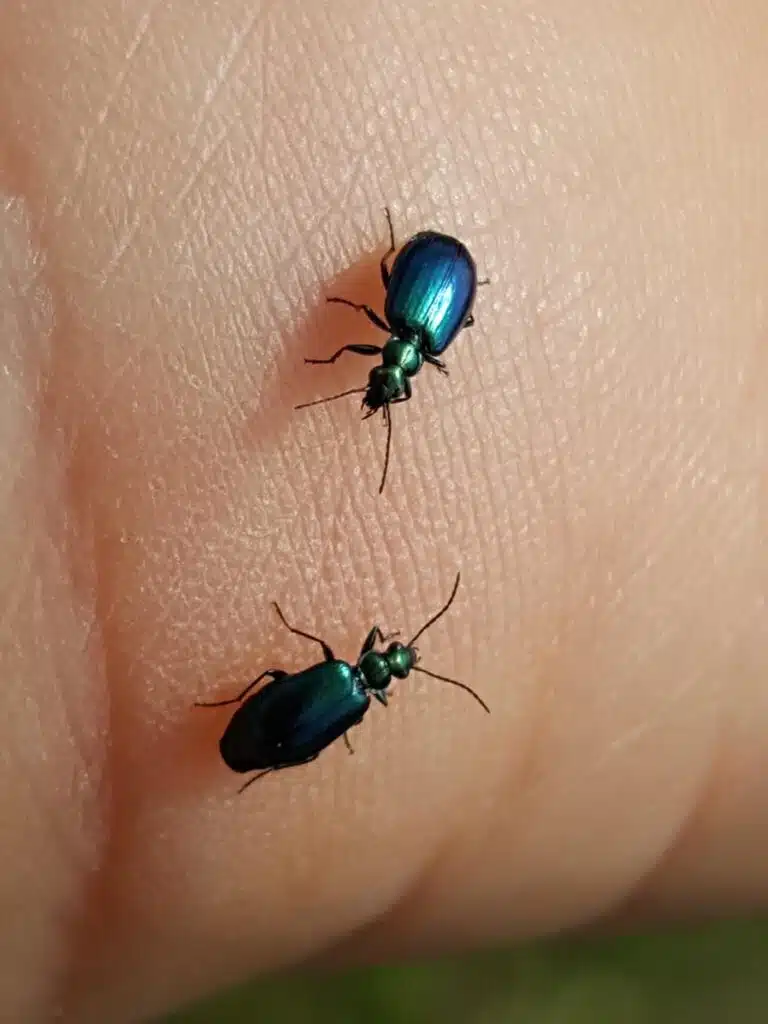
With a similar glossy green color to the Splendid Earth-boring beetle, the Flower Lebia beetle (Lebia viridis) has a smaller head compared to the elytra.
Its dark green color is metallic and it makes it stand out even when seen on various types of vegetation.
Unlike other beetles problematic to the garden or crops, the Flower Lebia beetle is beneficial to crops.
It feeds on common bug pests such as The Colorado Potato beetle, a species known for its economic impact on potato crops.
This species has a limited range in the Eastern states of the US. It has an even more limited presence in the mid-western United States.
14. Coyote Brush Leaf Beetle
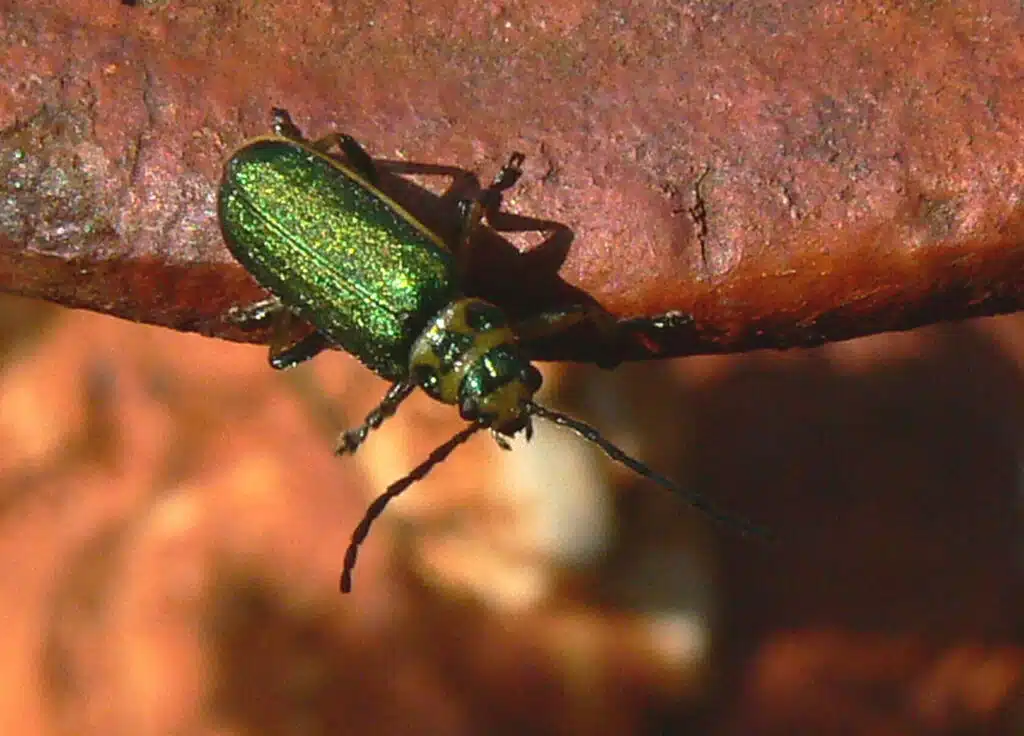
The Coyote Brush Leaf beetle (Trirhabda flavolimbata) has a metallic green body with dark green spots and black antennae.
Beetles of this species are common in Western US territories, especially in California.
As its name implies, it feeds almost exclusively on Coyote brush.
The impact of the species on this plant species can be impactful.
However, the Coyote Brush Leaf beetle also feeds on wildflowers known to deter pests. Flowers such as asters are often consumed by this beetle.
Asters are often used at home to protect gardens from the impact of various bugs such as scale insects or aphids.
15. Emerald Flower Scarab
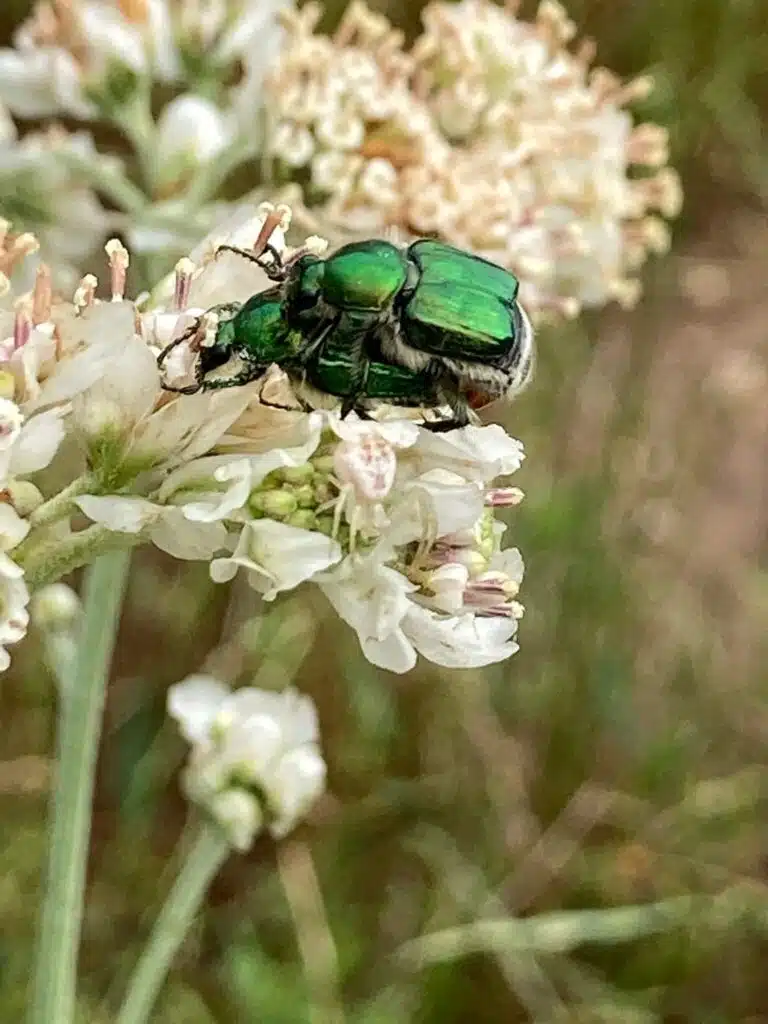
Emerald Flower scarabs (Trichiotinus lunulatus) have a green-black body with a metallic undertone.
Fine white hairs are seen on the edges of its elytra while its head is almost completely black.
Growing to a size of around 10mm, these bugs grow fine white hairs to avoid predation by camouflage.
Some of the Emerald flowers they feed on have white flower buds. As a result, this species grows white hairs so that it blends in with the flower buds and avoids predation from birds and large wasps.
16. Eggplant Tortoise Beetle
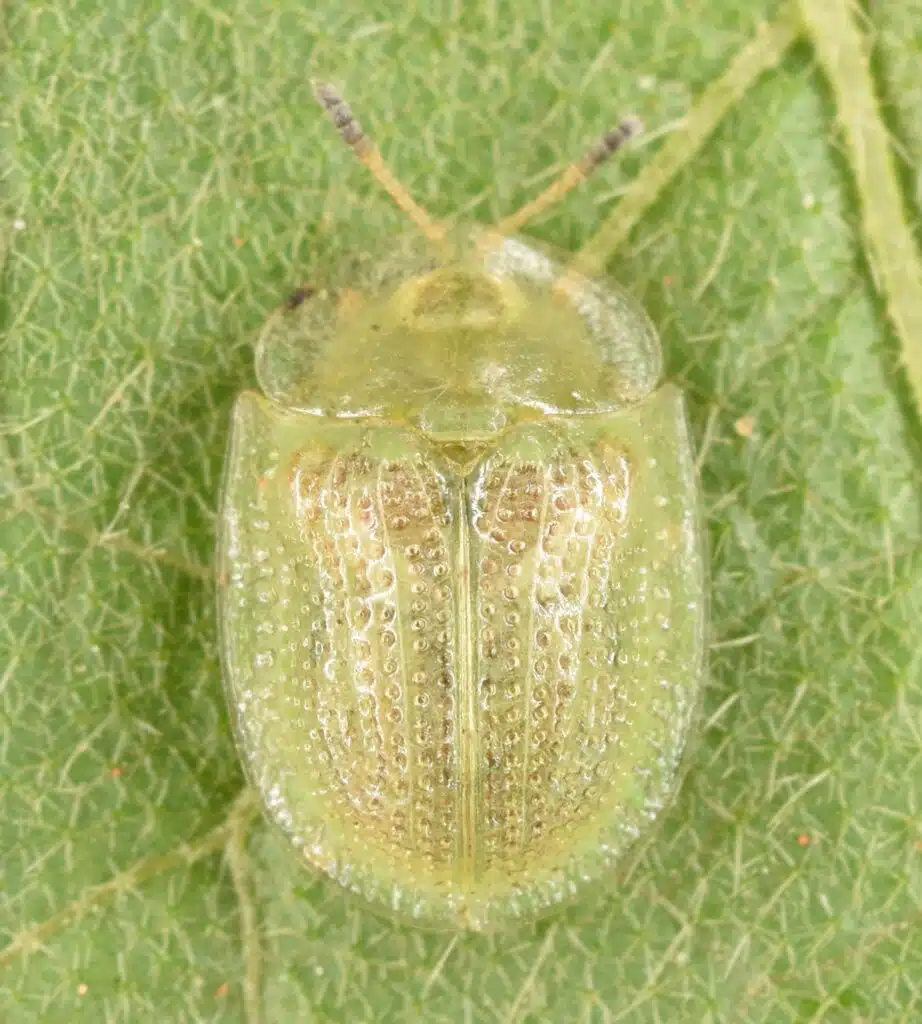
The Eggplant Tortoise beetle (Gratiana pallidula) is one of the species named after its physical description.
Beetles of this genus are shaped similarly to tortoises which makes them easily distinguishable.
Green and yellow are the main colors of the beetle. It has a base green color with yellow markings and a golden-yellow thorax.
This beetle primarily feeds on eggplant. Considered a pest, the Eggplant Tortoise beetle eats eggplant leaves until it finally kills the plant.
These beetles can be removed by hand or eliminated with insecticide.
17. Virginia Metallic Tiger Beetle
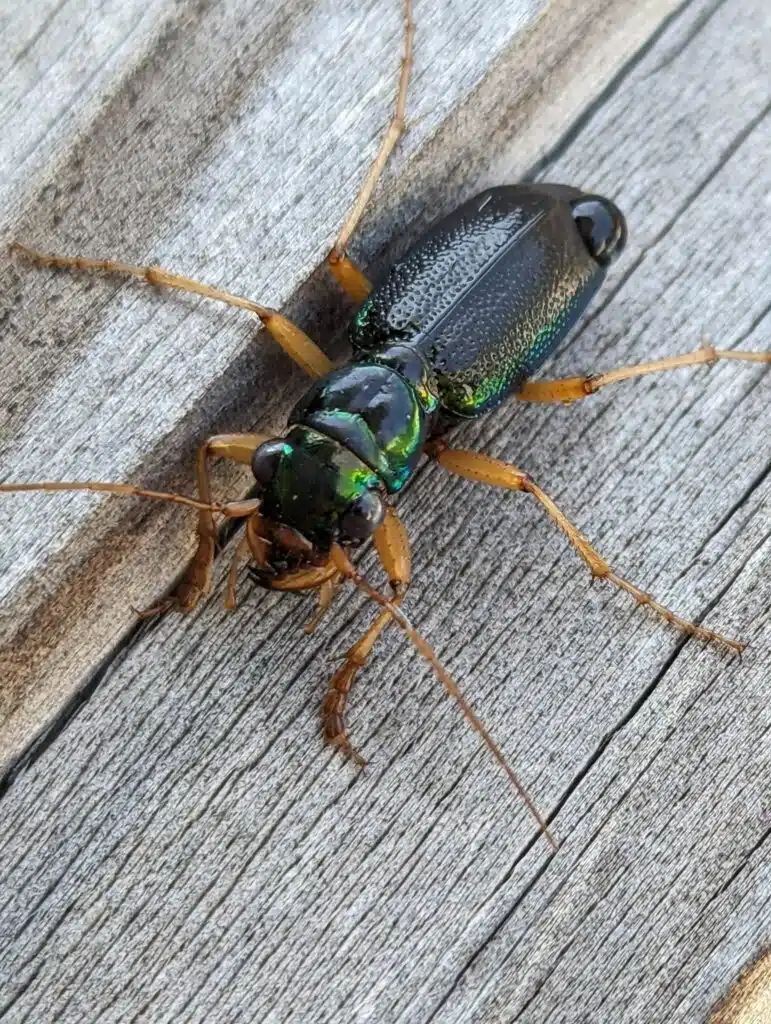
Virginia Metallic Tiger beetles (Tetracha virginica) are some of the fastest shiny green beetles in the world.
These beetles can reach speeds of up to a few miles per hour when sprinting which aids them when it comes to catching prey.
Virginia Metallic Tiger beetles are predators and they use their speed to outrun small bugs and insects.
They have a dark green color with a shiny head and thorax. The legs of the species vary in color and can either be light brown or yellow.
These beetles also stand out with very long antennae. Their antennae are as long as their legs.
18. Banded Cucumber Beetle
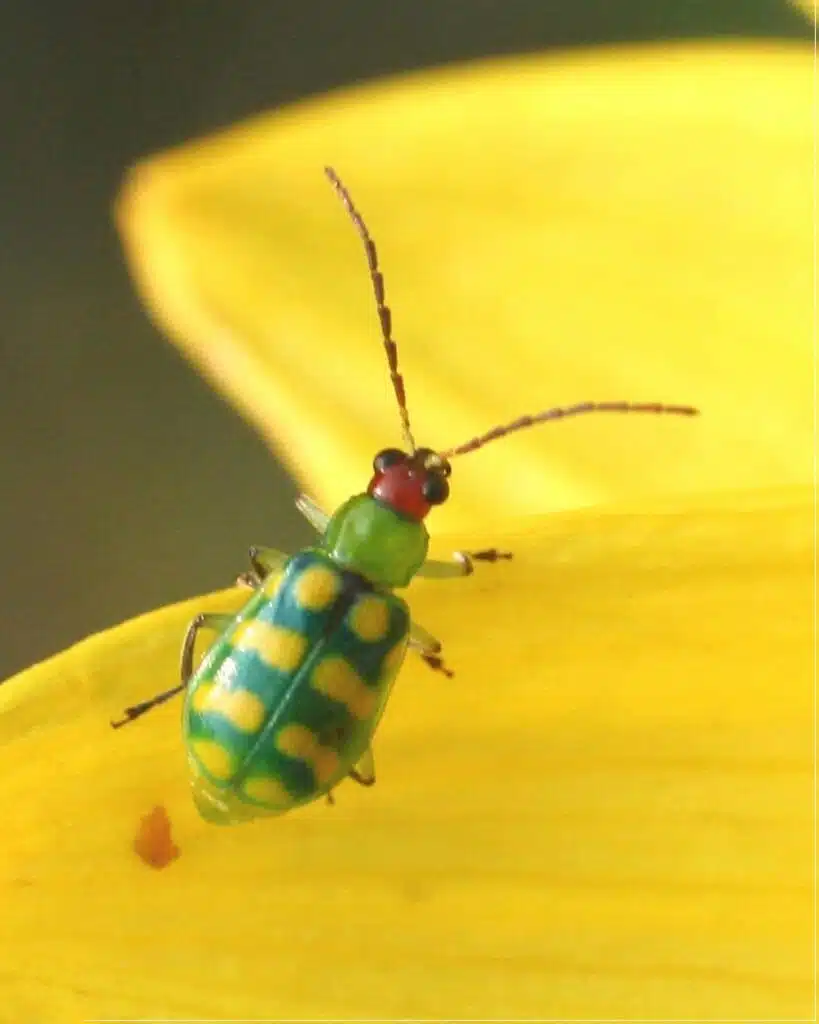
Growing to a size of up to 6mm, Banded Cucumber beetles (Diabrotica balteata) have a dual yellow-green shiny color. These bugs show yellow and green stripes on the elytra while the thorax is green with a yellow mark.
As their name implies, the beetles are mostly interested in cucumbers but they also affect squash, onion, eggplant, and other vegetables.
The impact of the species on vegetables can be considered as adults feed on foliage and flowers and their larvae on the roots of vegetables.
As a result, this species is a known pest and it needs to be eradicated from crops.
The only non-chemical solutions against Banded Cucumber beetles are nematodes.
19. Thistle Tortoise Beetle
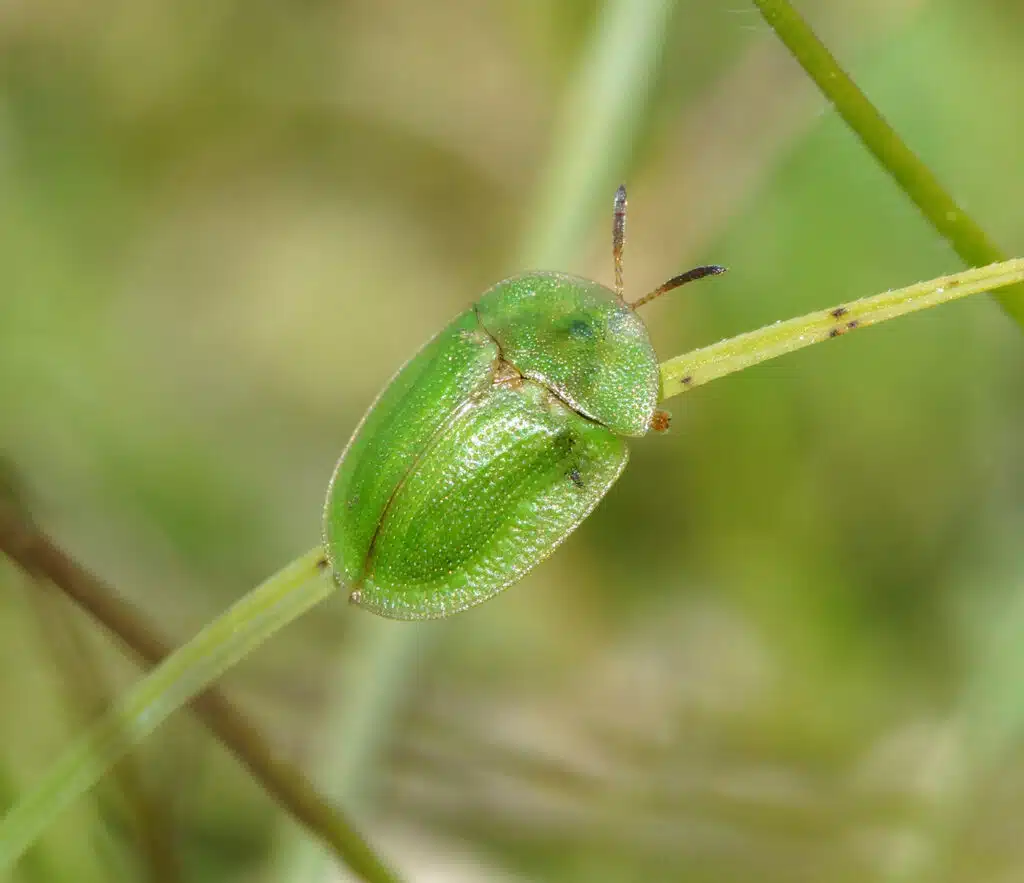
Thistle Tortoise beetles (Cassida rubiginosa) also get their names from having a physical resemblance to turtles.
Beetles of this genus have a round flattened body that resembles the body of turtles.
The base color is green with soma dark brown edges around the elytra.
This green beetle is native to Europe and Asia. It has been introduced to North America as an attempt to control the thistle that invaded crops across the country.
Early attempts to use it as a control agent in Virginia were successful so the beetle was encouraged in many other states to have a widespread presence in the US today.
20. Bumelia Borer
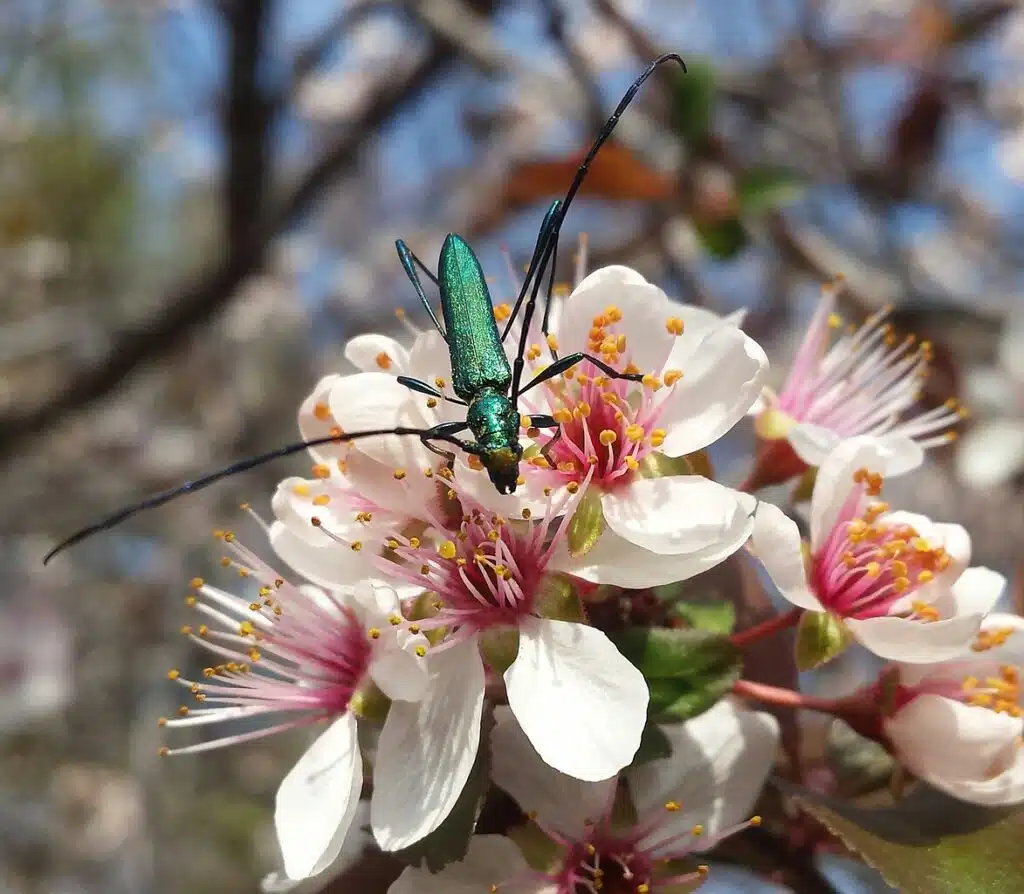
Common in Southern states, the Bumelia Borer (Plinthocoelium suaveolens) is one of the shiny green beetles that have a growing presence in North America.
Beetles of this genus have some of the most colorful bodies as they have a base shiny green color with brown legs.
The thorax is iridescent. It changes color as it reflects light and it can appear golden or green as well.
These beetles are invasive and they cause the death of Bumelia trees, locally known as Bully trees.
Adults feed on their leaves while Bumelia borer larvae feed on the roots of these trees.
21. Blue Dock Beetle
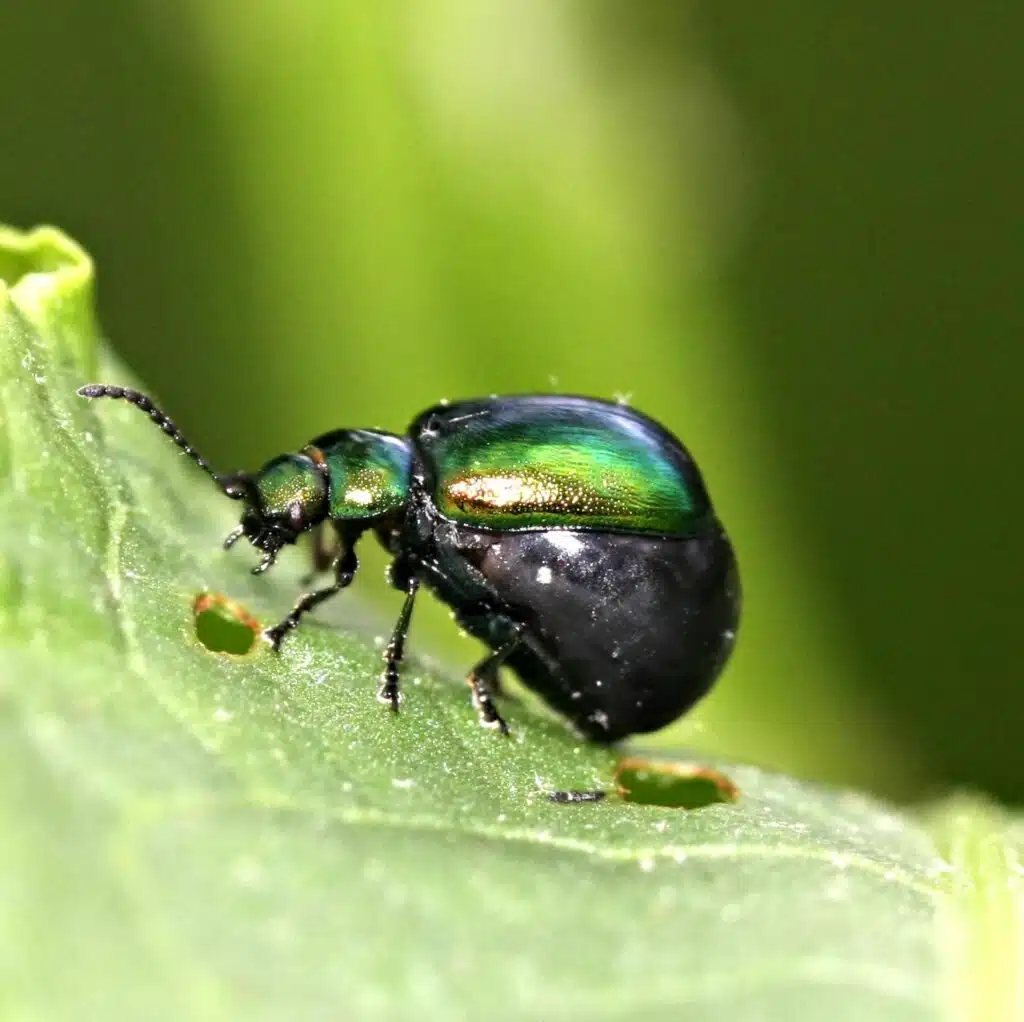
Blue Dock beetles (Gastrophysa cyanea) have a glossy green body. The shape of their body is as striking as the color.
Known for having a dome-shaped body, these beetles resemble lady beetles in shape.
The green color these bugs have is uniform.
Darker than the green color of leaves these beetles eat, the color doesn’t help them with camouflage but it makes them look poisonous to predators. is uniform.
Darker than the green color of leaves these beetles eat, the color doesn’t help them with camouflage but it makes them look poisonous to predators.
Beetles of this family grow to a maximum size of 5mm and they spend most hours of the day eating leaves.
22. Emerald Euphoria
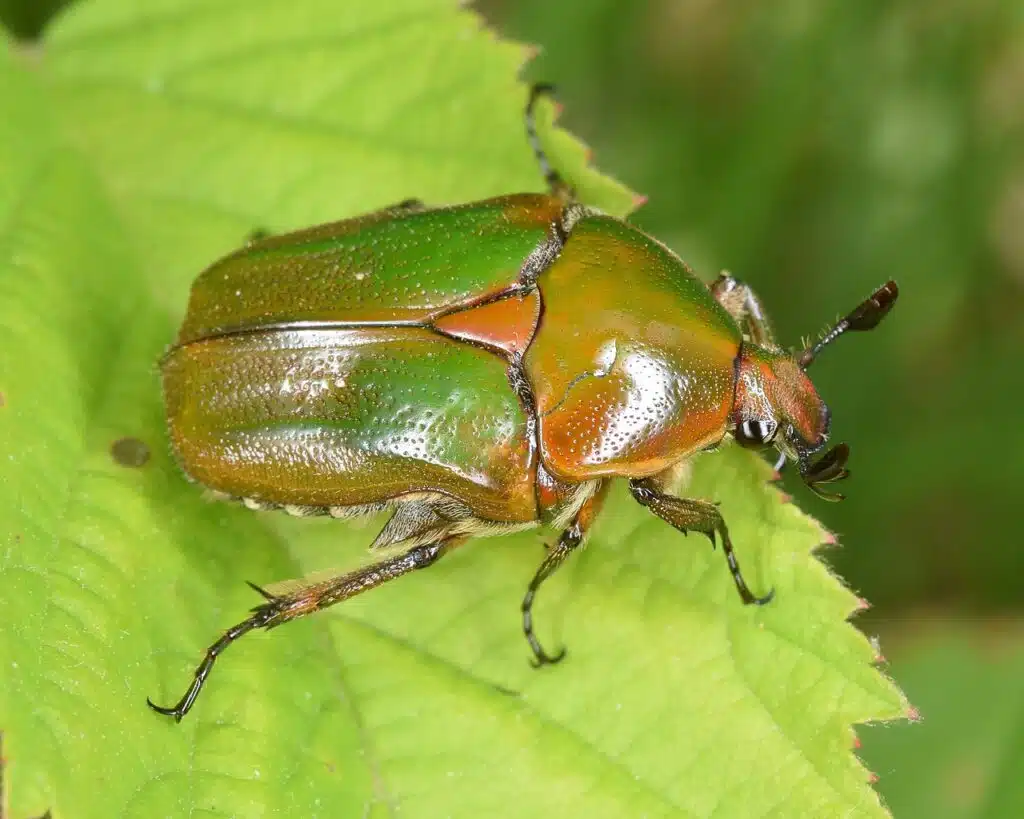
Emerald Euphoria beetles (Euphoria fulgida) are largely unknown in North America despite being seen in multiple states.
This beetle has a base green color. This color is barely visible due to the golden-yellow coloring on its body that makes it appear shinier.
The beetle has very specific dietary requirements which means it cannot be seen anywhere out in nature.
Most Emerald Euphoria beetles are seen on plum trees in the US. They feed on pollen and nectar of these trees but are considered a minor pest.
Real threats to plum trees caused by Emerald Euphoria beetles are rare since these beetles have short lifespans.
23. Green Blister Beetle
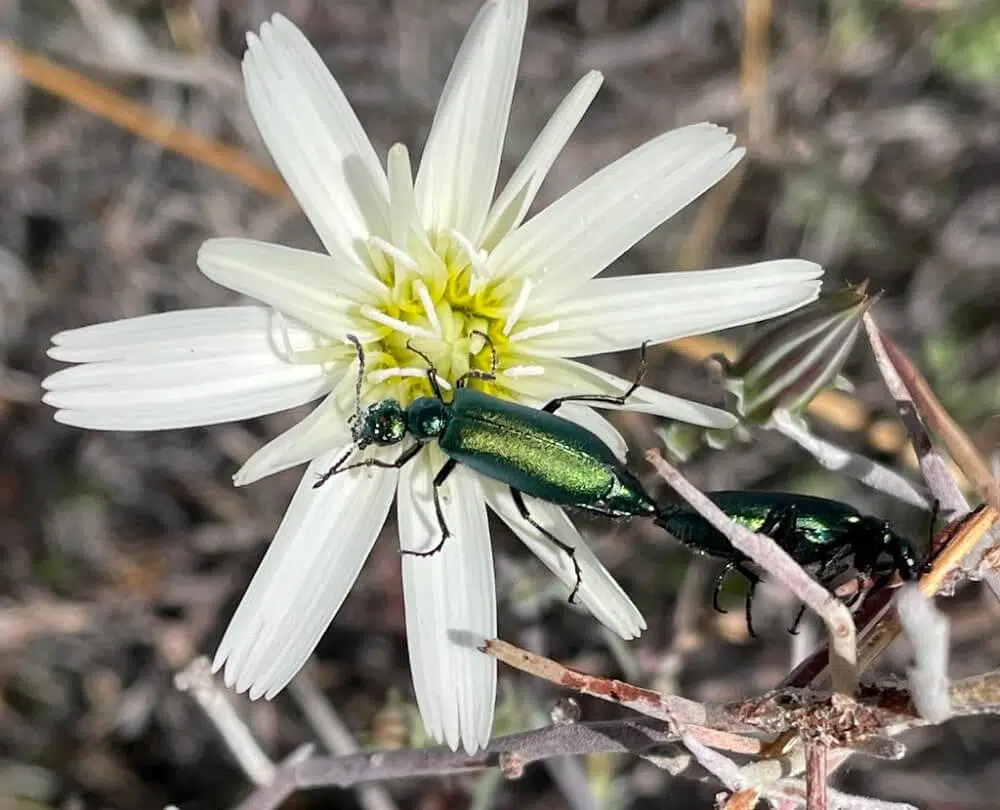
Green Blister beetles (Lytta stygica) have a dark green body with a metallic undertone.
These beetles grow to a size of up to 22mm and they are common in North America from Mexico to Canada.
Green Blister beetles absorb plant toxicity and they have a very bad taste which sometimes males’ larger prey spit the beetle out.
These elongated green beetles are mostly found on flowers where they eat pollen and nectar.
24. Glorious Jewel Scarab
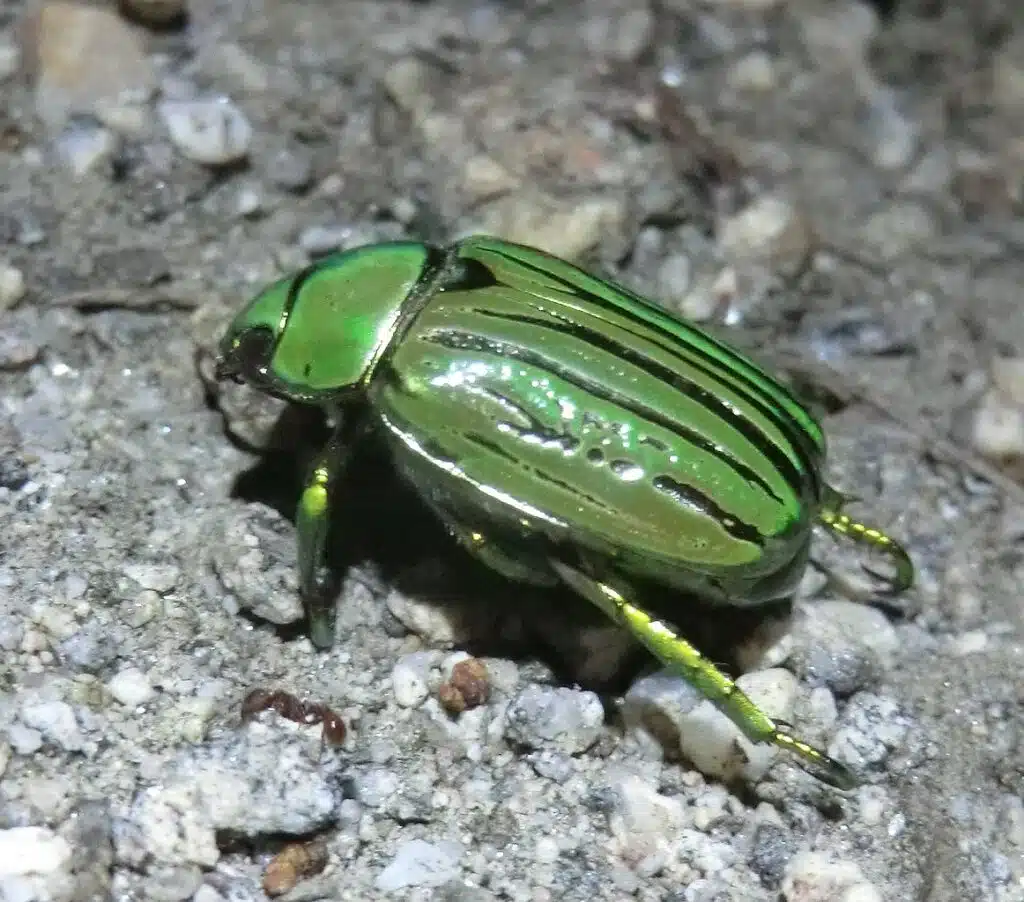
The Glorious Jewel scarab (Chrysina gloriosa) has a dark green body with deep grooves that have a light green color.
The thorax, head, and legs of this species are also green.
Most Glorious Jewel Scarabs are found in areas of Texas and Arizona, particularly at high altitudes.
It’s here that the adults feed on juniper leaves while the larvae feed on plant roots.
The dark color of Glorious Jewel scarabs allows them to maintain very good camouflage when eating juniper leaves.
Even people rarely notice these scarabs immediately as they solely live and have adapted to the color of juniper leaves.
25. Phanaeus igneus

This species of dung beetle is known for its rugged green and iridescent body color.
The elytra have a shiny green color while its head and cephalothorax have a reflective color that changes their appearance regularly depending on how it reflects light.
Beetles of this genus are known for moving slowly and they can easily be seen in animal dung due to their reflective coloring.
They also have a horn that has either a dark green or a black color which resembles the dark green to black color of its legs.
26. Pale Green Weevil
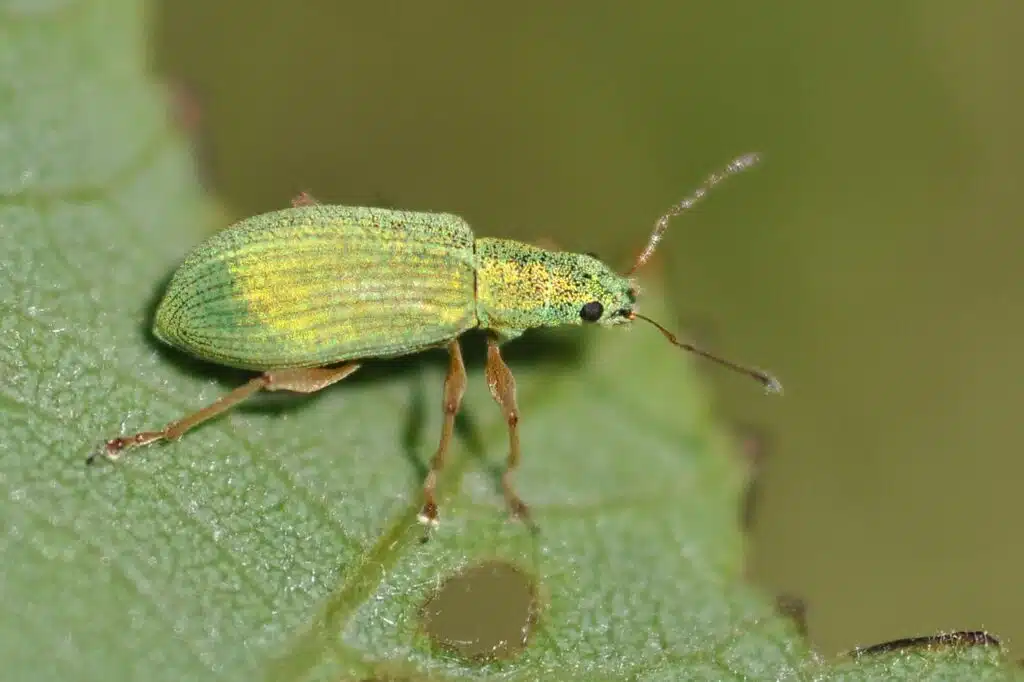
The Pale Green Weevil (Polydrusus impressifrons) is a species introduced to North America almost a century ago.
It’s believed it arrived from Europe and it has established itself on the East Coast first.
These beetles have a uniform green color. The elytra, thorax, and head have the same green color.
Small ridges are seen on its elytra.
The Pale Green Weevil feeds on the leaves of various trees such as oak and weevils.
Larvae of this species feed on the roots of these trees.
The impact of the species on the trees they infest is considered insignificant. They are always found in small numbers on mature trees which means they pose no real threat to the trees they feed on.
27. Common Claybank Tiger Beetle
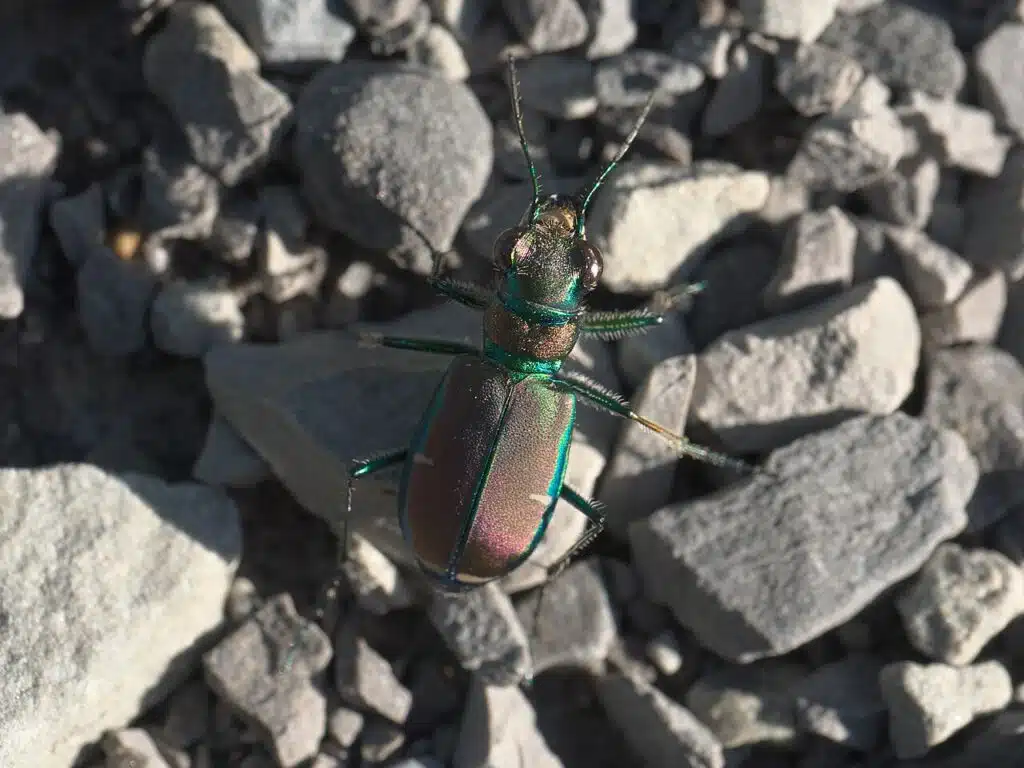
The Common Claybank Tiger beetle (Cicindela limbalis) is a predatory species which variable sizing.
Its maximum size varies from 12 to 22mm but the beetle is easily identifiable by its tripe color body.
The beetle has marron-brown color on the elytra and the cephalothorax. Yellow or tan spots are also visible on its body.
Beetles of this genus have shiny green coloring on the edges of the elytra, thorax, and head. Its legs also have a shiny green color.
These beetles also show fine white hairs around the elytra and on the legs.
Some members of this species have shorter white hairs on the head.
28. Phanaeus differs
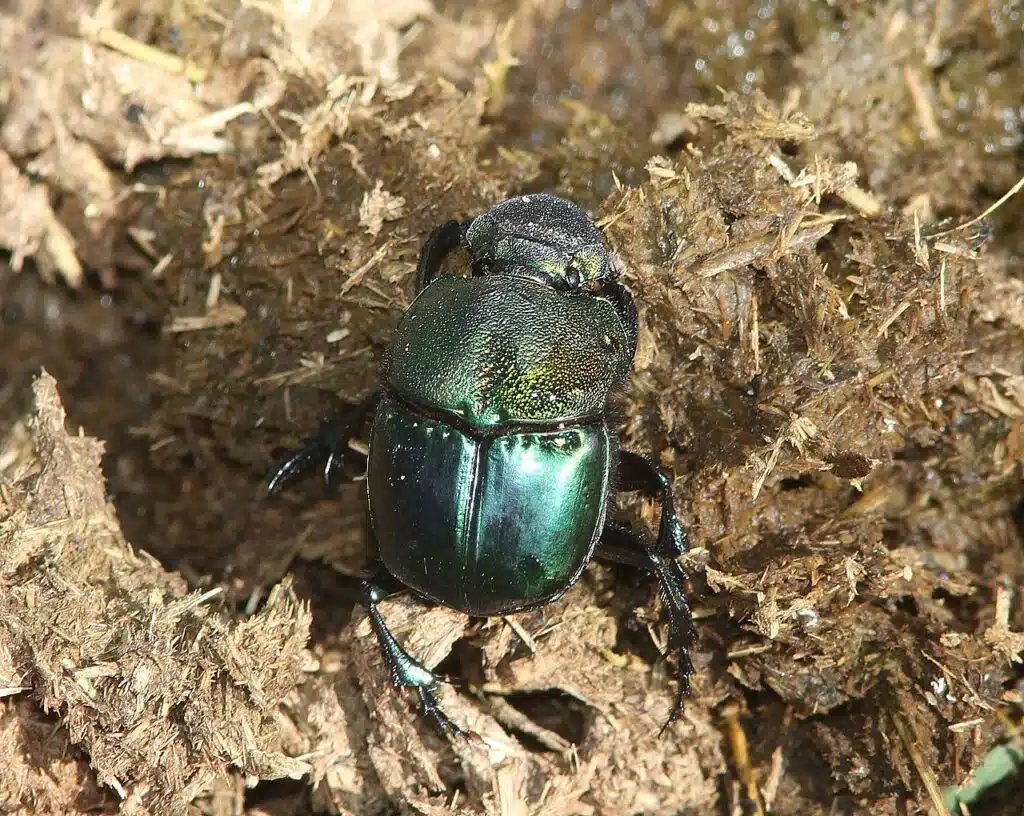
This dung beetle is known for its very colorful body.
It has both green and blue colors and an iridescent hue on its head.
The species is dominated by a metallic color on its body which brightens its blue and green sections.
It also has a long black horn.
This species has been reported in coastal areas. It has a widespread presence in Texas and California.
Beetles of this genus feed on dung and they are normally seen around various drainages of large cities in the Southwestern US.
29. Beyer’s Jewel Scarab
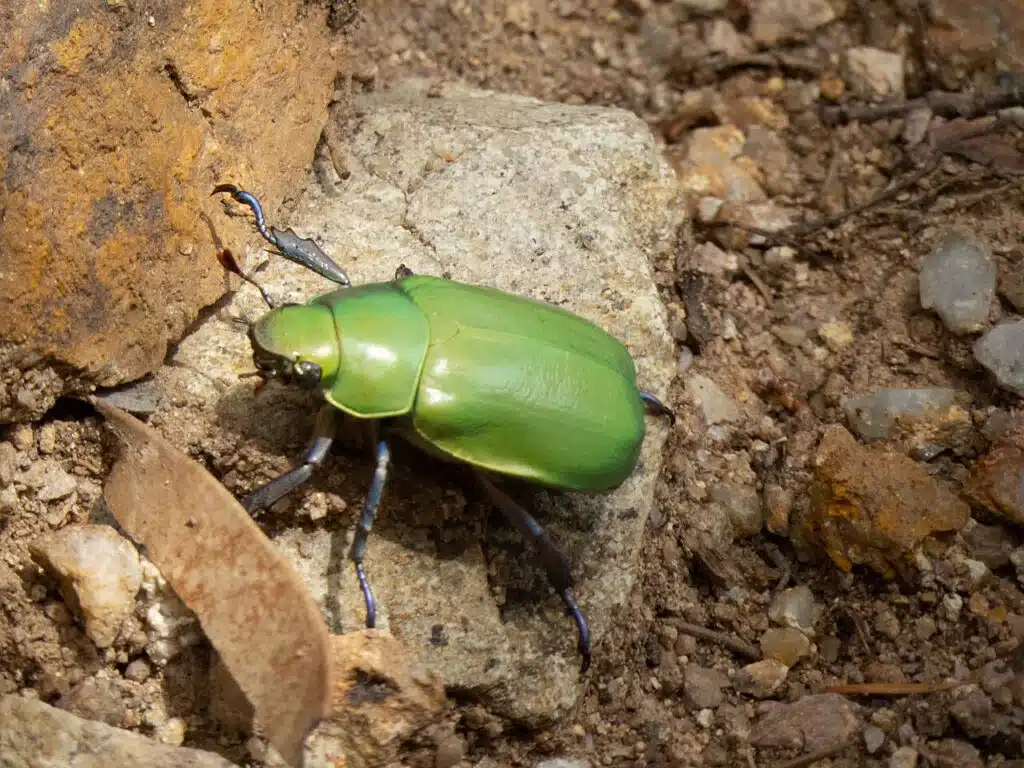
Beyer’s Jewel scarab (Chrysina beyeri) is common in Northeastern US territories.
This is a species of green scarab beetle that appears in May and remains active until October.
Identification is based on its colorful green body. Beetles of this family have a basic uniform green color.
Brown bands or brown coloring are seen on the edges of its elytra. A faint brown mark is also distinguishable on its head.
These beetles are known for not having a horn or any other type of dots and marks in all of their morphs.
The species can be large by comparison as it grows to more than 1 inch as an adult.
30. Green Claybank Tiger Beetle
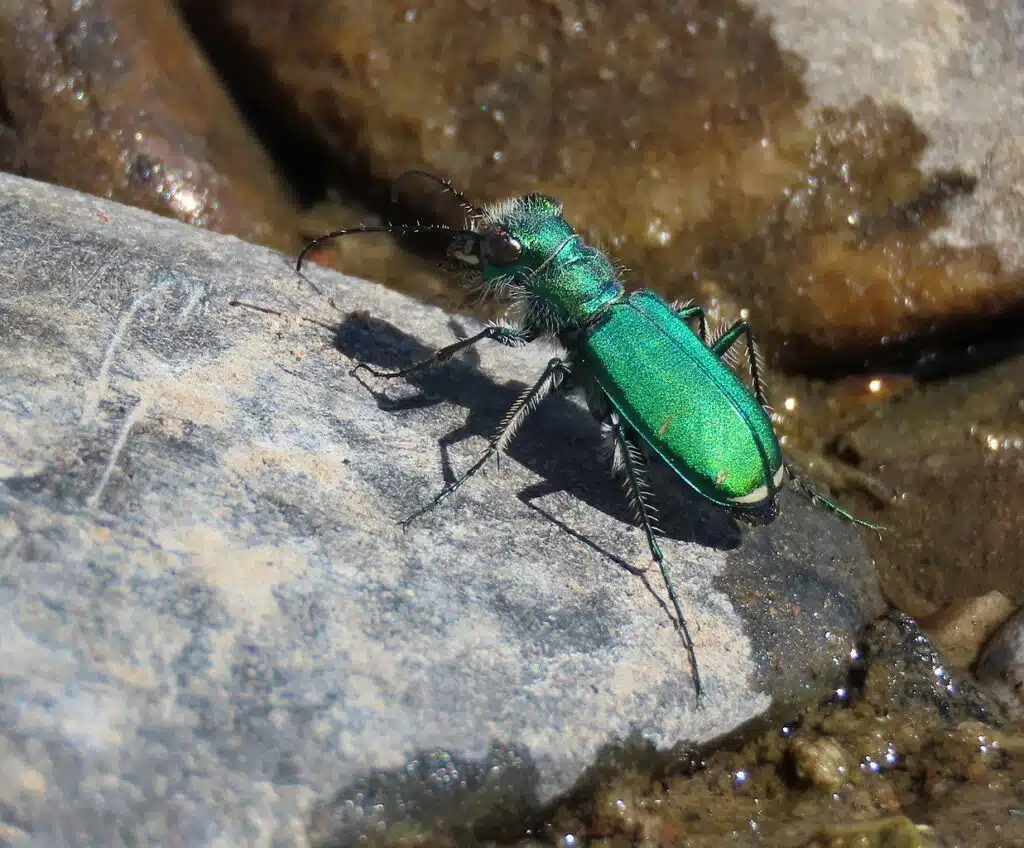
This species of tiger beetle (Cicindela denverensis) is known for its love of arid habitats.
It lives on the ground in areas with reduced vegetation but it’s mostly known for its vivid coloring.
The Green Claybank Tiger beetle has a shiny metallic green body color.
This color is almost uniform as the beetle doesn’t have any spots or colored body margins.
Beetles of this genus appear to shine in direct sunlight due to their metallic undertone green coloring.
Native to North America, the beetle is active throughout the year
31. Golden Ground Beetle
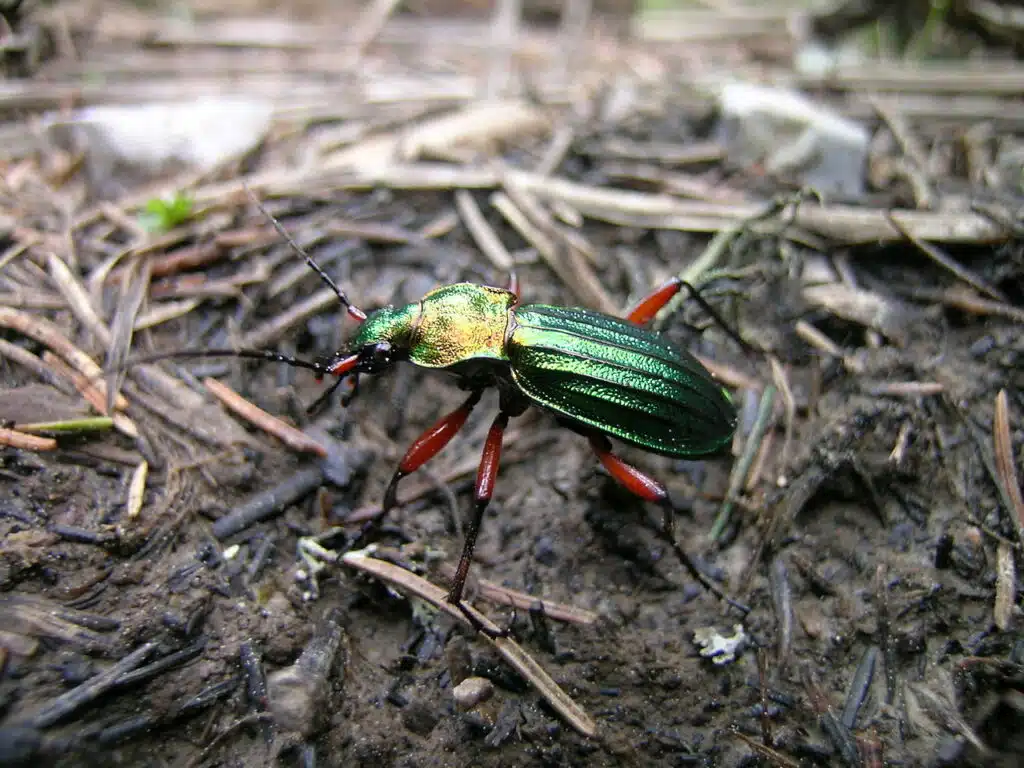
This species of beetle (Carabus auratus) has a golden-green color. It has iridescent golden coloring on a striped green body which makes it shine.
The sight of the beetle can be both good news and bad news. It’s bad news for a lot of small insects as this beetle is an avid predator. It even eats earthworms.
However, seeing this beetle in gardens is beneficial for farmers as they know the species starts killing and eating invasive pests.
One of the strengths of this beetle is the capacity to eat entire prey as it sprays them with a liquid that starts decomposing them to be easier to eat.
32. Dispirited Tiger Beetle
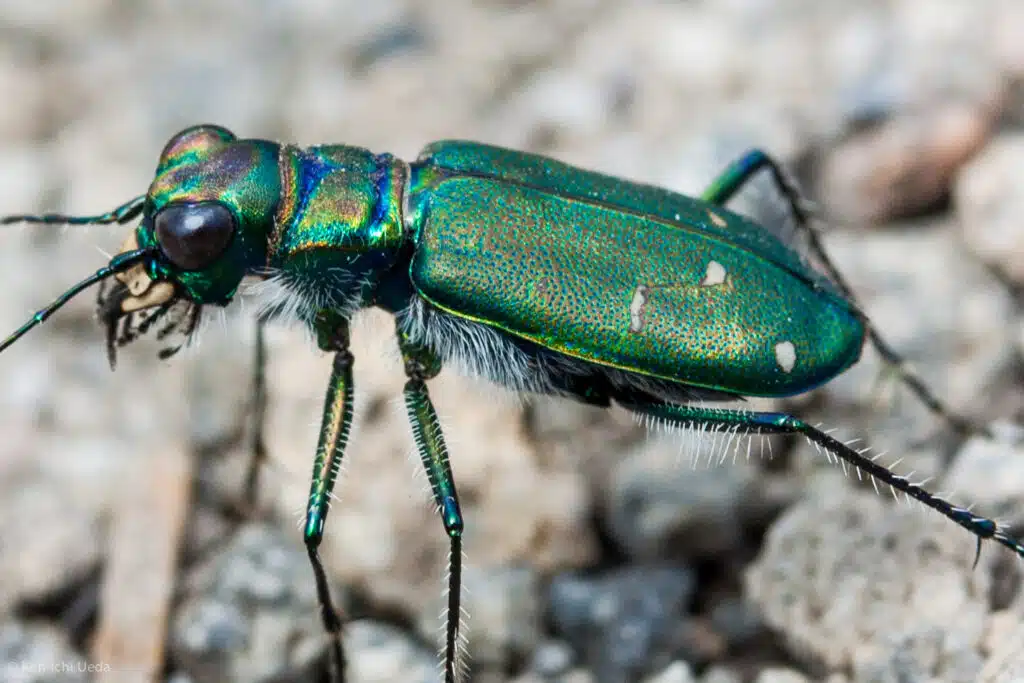
Tiger beetles are known for moving fast. The Dispirited Tiger beetle (Cicindela depressula) is no different.
Beetles of this species are also known for their vivid colors. They have metallic shiny blue elytra with a green tint and green to the blue thorax and head coloring.
Like many other tiger beetles, this species also has colorful spots on the elytra.
Yellow colors are common on the elytra and they represent one of the traits which help the species improve camouflage.
The spots on the elytra always have the color of its environment, which is mostly dirt and rocky terrains.
33. LeConte’s Chrysina
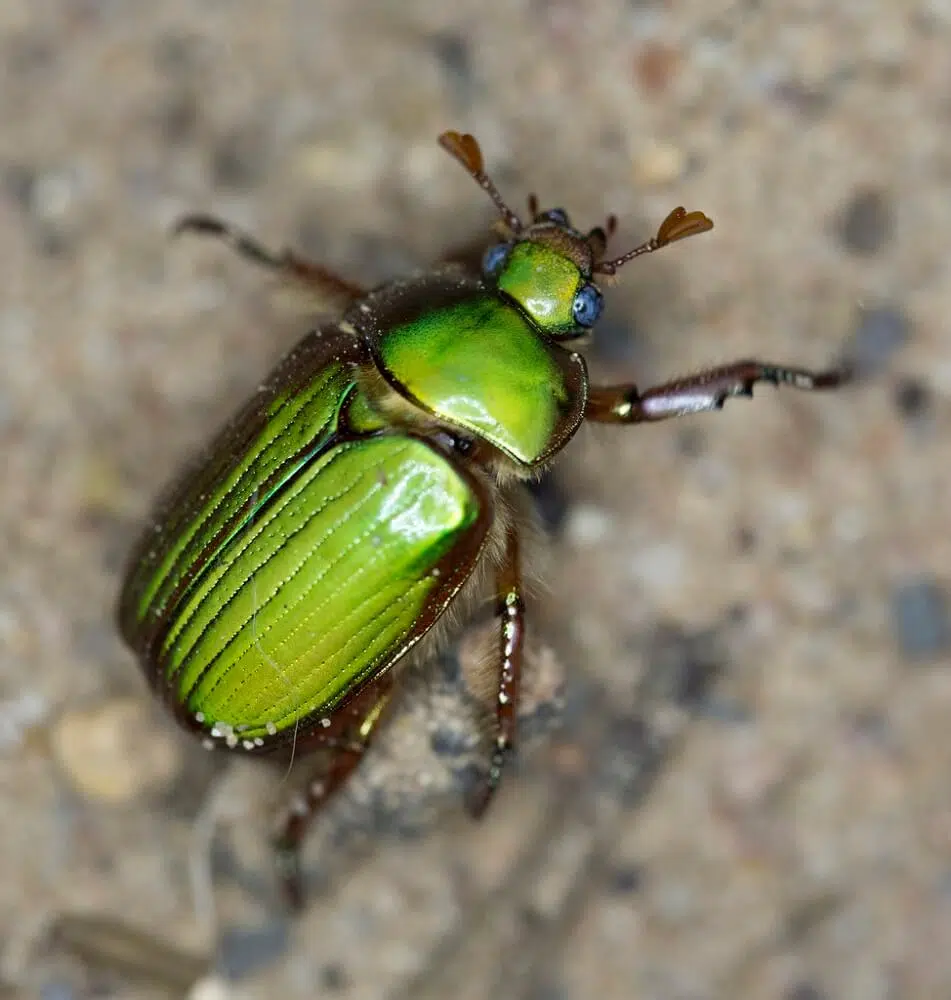
This species of shiny leaf beetle (Chrysina lecontei) is found in the US.
Known for its wide distribution, LeConte’s Chrysina has dark green coloring with grooves and dark brown elytra edges.
Beetles of this genus also have dark brown legs.
The beetle is also known for sometimes having a yellow tint. This tint is present in the form of a central stripe on the elytra and sometimes seen on the lower part of the thorax.
The coloring of the species resembles the leaves it eats and lives on.
34. Striated Jewel Beetle
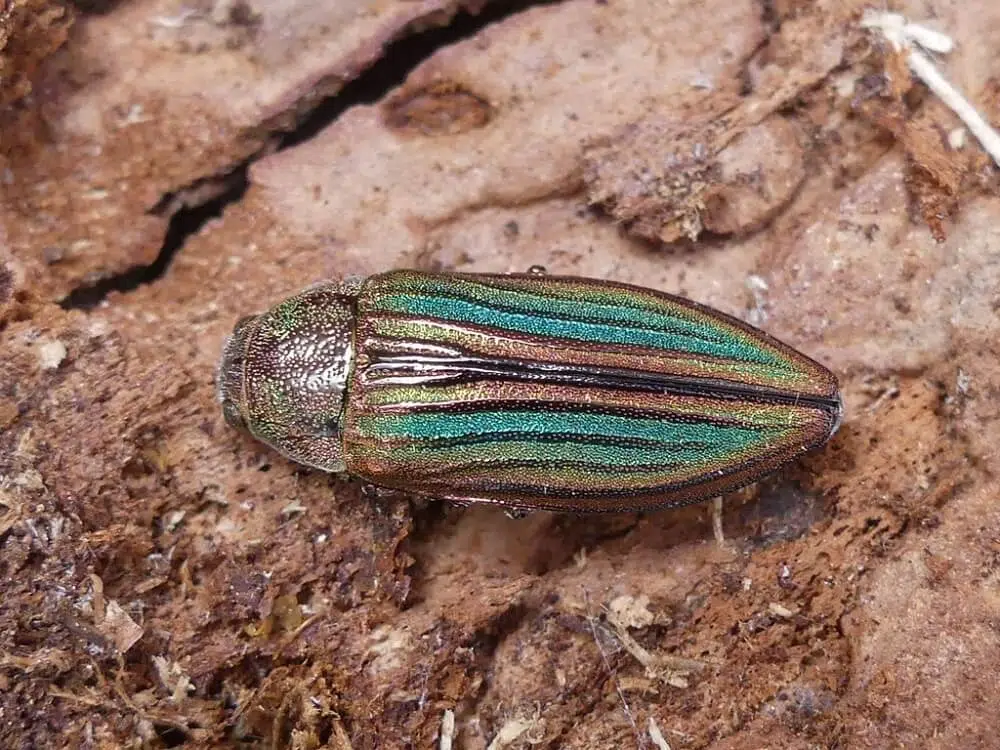
The Striated Jewel beetle (Buprestis striata) is one of the green bugs with a golden hue.
Its elytra are striated as its name implies. The beetle can be as long as 80mm and it’s seen on trees it eats.
The Striated Jewel beetle doesn’t always eat the fresh trees as it bores into decaying trees.
Beetles of this genus are also known for favoring decaying branches of trees as these have softer fibers.
The Striated Jewel beetle prefers hardwood trees it finds in Northeastern US territories.
35. Northern Barrens Tiger Beetle
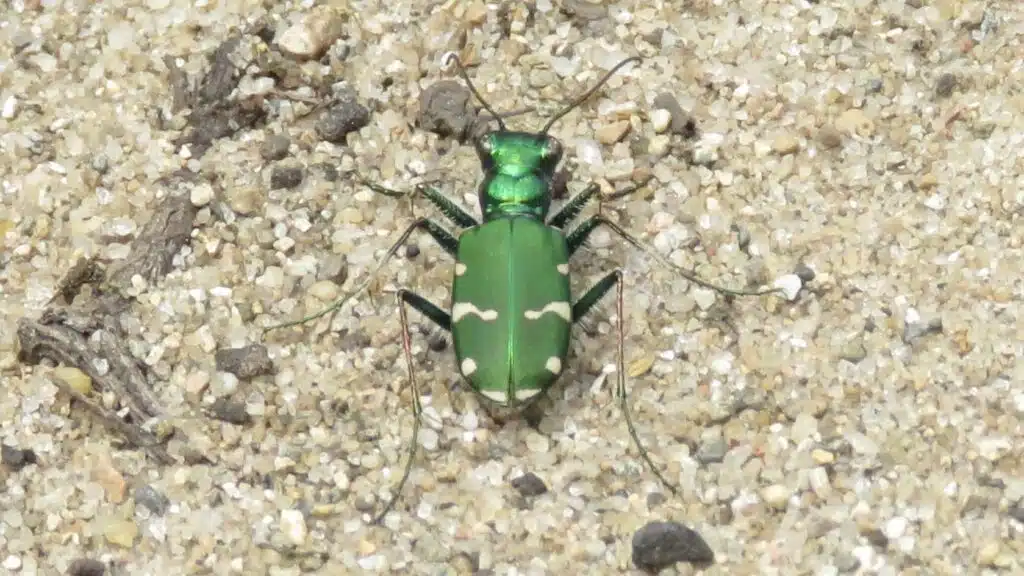
The Northern Barrens Tiger beetle (Cicindela patruela) is one of the common species in Northern US territories and Canada.
As its name suggests, this beetle is only present in the Northern habitats of the US but it resembles tiger beetles found elsewhere.
It has a dark green metallic body.
The elytra are darker than the thorax but both the elytra and the thorax have a glossy appearance in full sun.
White or cream spots are also distinguished on the elytra of this species.
Its legs are both dark green and light green resembling its body. Beetles of this species are mostly found on sandy soils.
36. Green Pubescent Ground Beetle
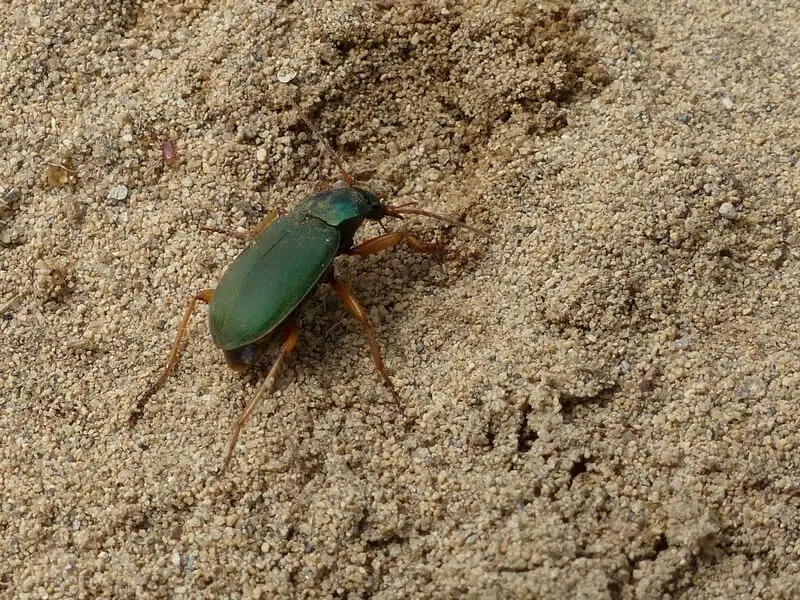
The Green Pubescent Ground beetle (Chlaenius sericeus) has a deep green color.
Its coloring is very dark but it maintains glossy elytra like many other ground beetles.
The head of these beetles is partially green and partially black.
Its legs are yellow or light brown.
These green beetles are also known to store various toxins which they can release against predators. Toxins are stored until these beetles face immediate danger and can be released against a predatory.
A popping sound can sometimes be heard when these toxins are released.
37. Wood’s Jewel Scarab
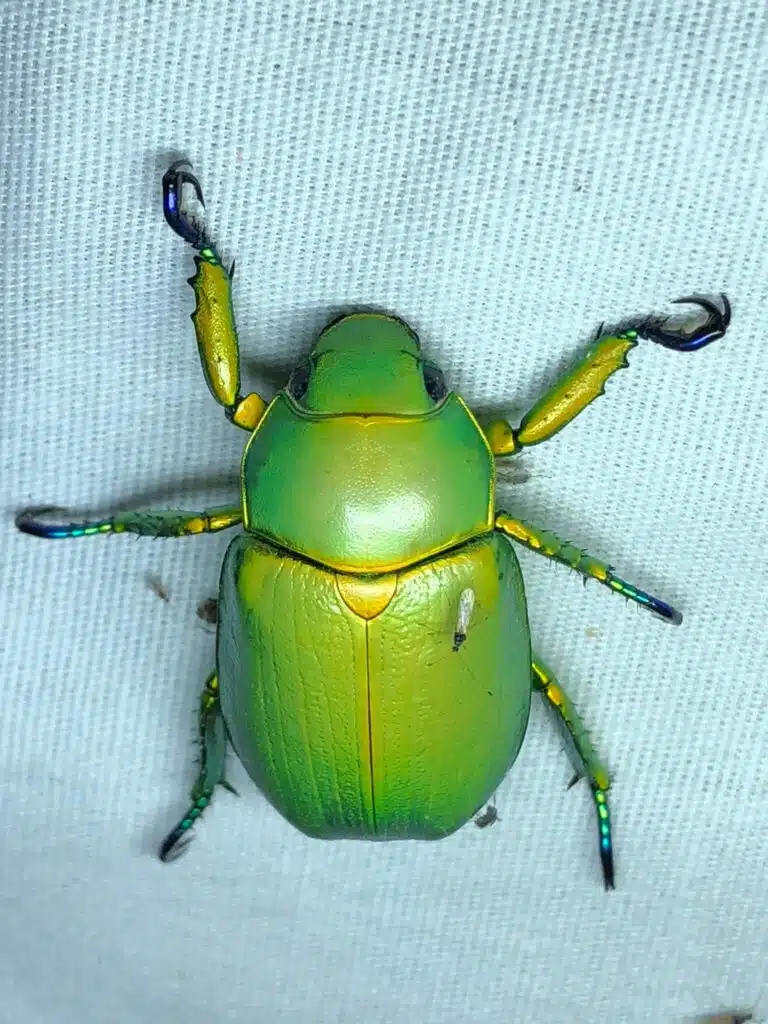
The Wood’s Jewel scarab (Chrysina woodii) is one of the oldest studied species in North America.
It has been described more than a century ago. This beetle is now identified by its uniform green color.
The green nuance is light compared to other green tiger beetles.
These scarabs are mostly interested in walnut leaves. The larvae of the Wood’s Jewel scarab are known for eating the roots of young walnut trees.
Unlike other scarabs, Wood’s Jewel scarabs don’t have fused wings. They can fly, albeit only over short distances.
38. Yellow-spotted Jewel Beetle
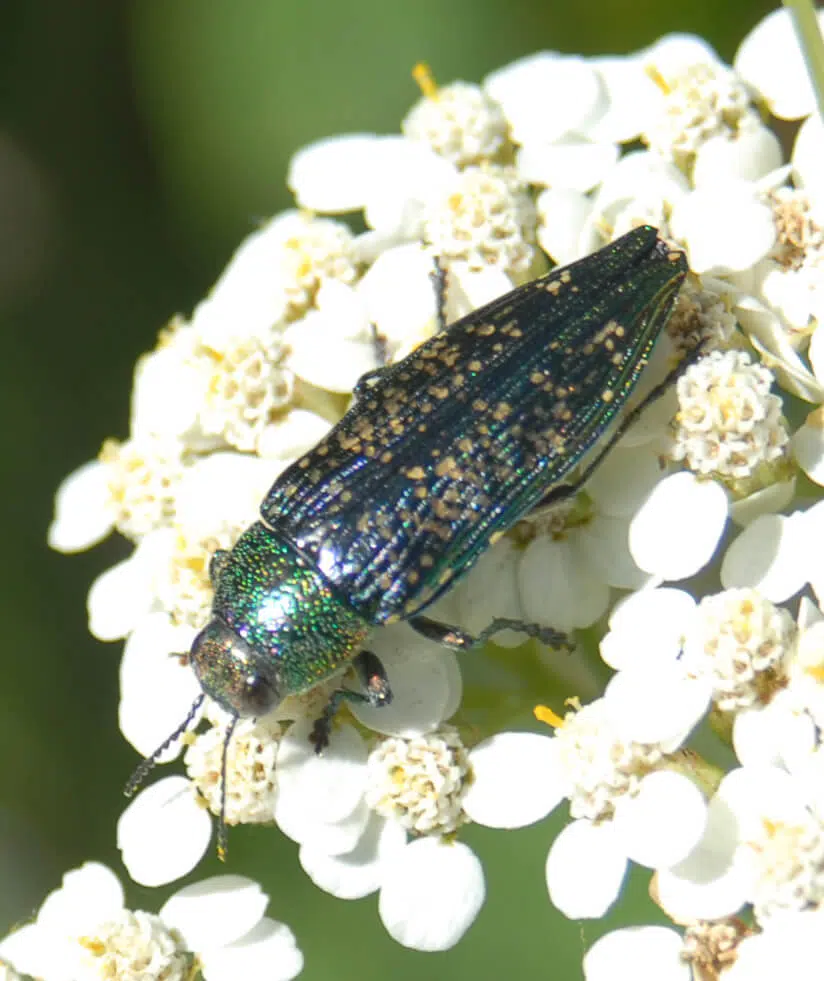
As its name implies, the Yellow-spotted Jewel Beetle (Buprestis confluenta) has multiple small yellow marks across its body.
This species is known to be one of the largest green beetles in North America as it can grow up to a length of a couple of inches.
These beetles are seen hiding during the day, typically under various leaves whenever they aren’t feeding.
Yellow-spotted Jewel beetles are known to eat pollen, nectar, and plant leaves.
They can also eat the leaves of various trees, particularly hardwood trees.
Yellow-spotted Jewel beetles can also fly, particularly at night to avoid predators.
39. Punctate Little Bear Scarab Beetle
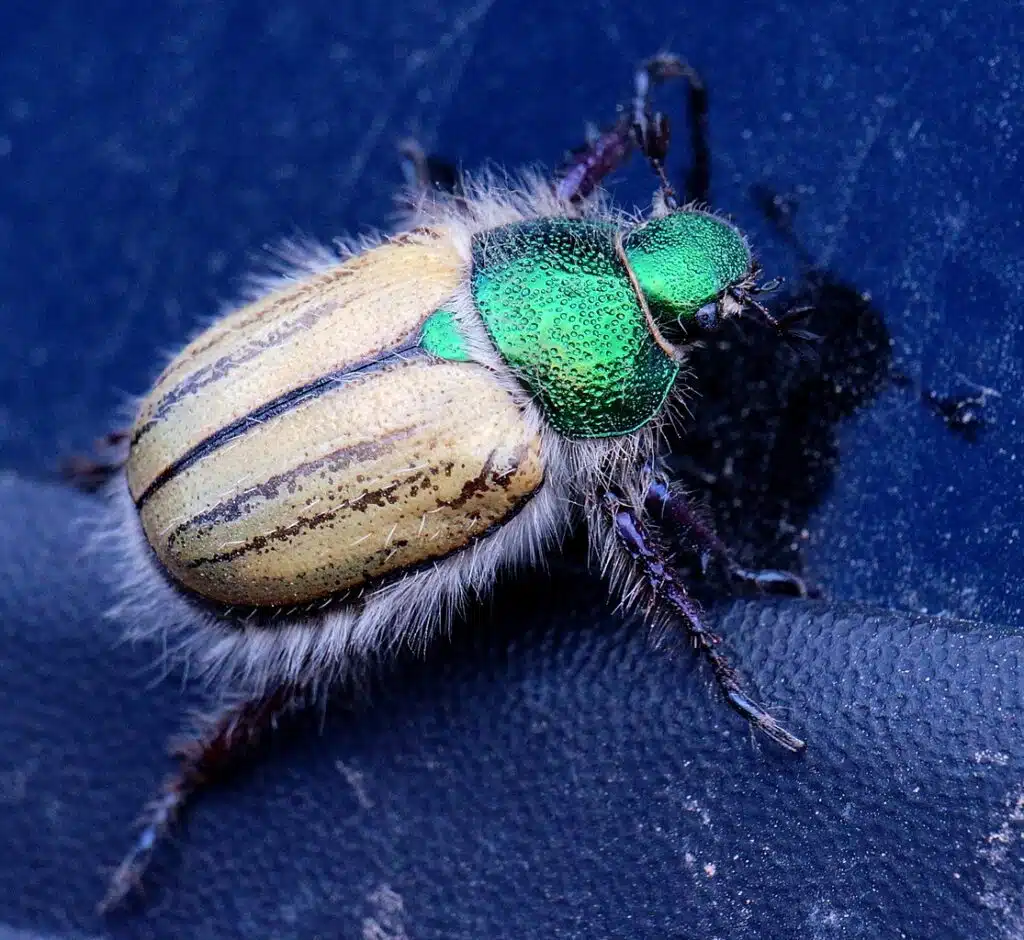
Found in Western US territories, the Punctate Little Bear Scarab beetle (Paracotalpa puncticollis) is one of the green species that looks similar to watermelons.
It has interrupted dark green stripes on its elytra which is bright green.
Beetles of this genus are further decorated with black spots on the upper elytra towards the edges.
The thorax and the head are dark green and may even appear black.
Beetles of this genus also have white hairs. These hairs are seen on the edges of the elytra.
This species of green beetle is specific to Northwestern US territories.
40. Temnoscheila acuta
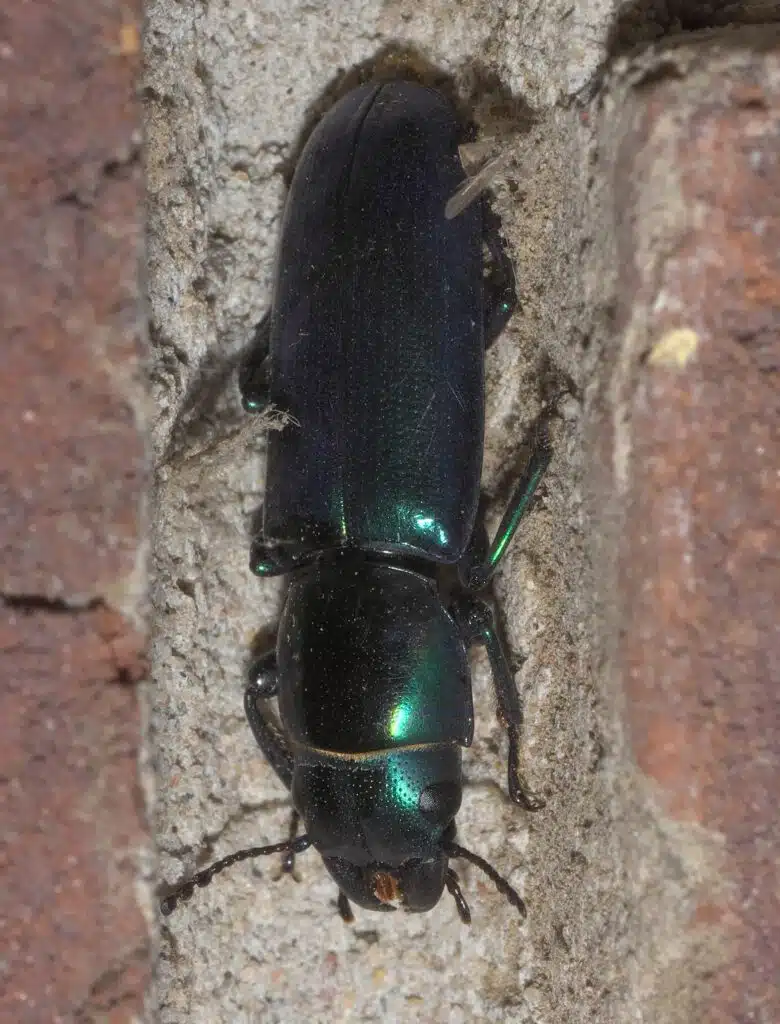
This species of beetle is known for eating and nesting in the bark.
One of the most distinct characteristics of the beetle is its metallic shiny green color which can appear to change nuance depending on how it reflects light.
Most areas on the elytra appear dark green while its head can appear black in certain light.
The species has a dark green color which gets darker towards the head.
It can sometimes be seen on tree bark but it can spend long periods under tree bark where it feeds on trees. It can cause significant damage to trees.
Temnoscheila acuta is one of the multiple species of the Trogossitidae family found in North America.
41. Blue-Green Citrus Root Weevil
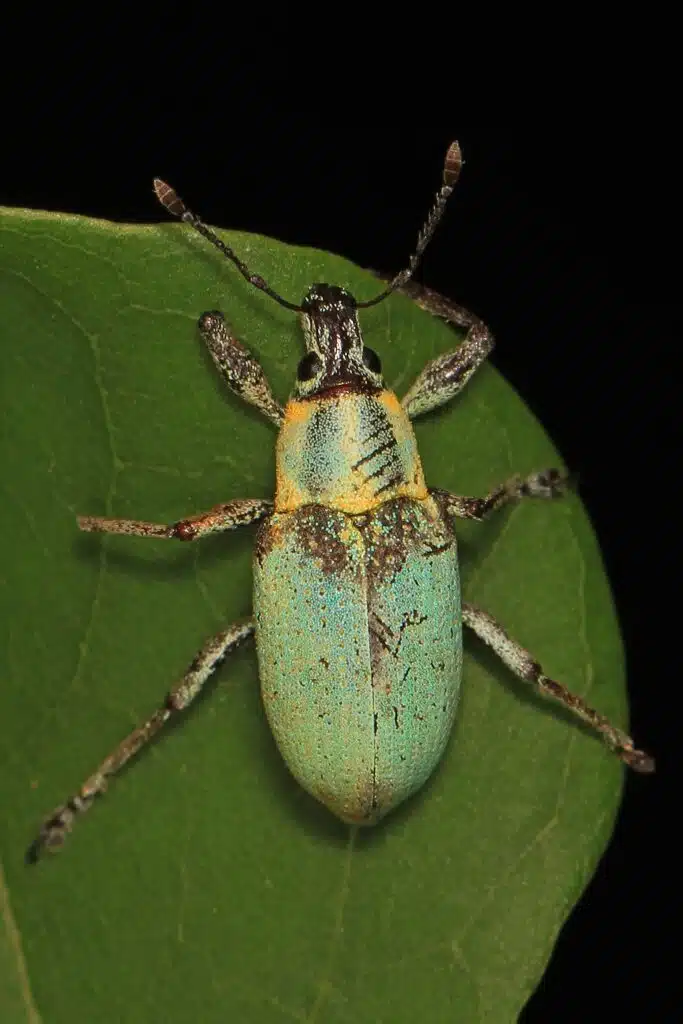
The Blue-Green Citrus Root weevil (Pachnaeus litus) is one of the multiple pests of citruses in North America.
This beetle has a mostly green color with blue nuances and yellow elytra edges.
The thorax also exhibits more yellow coloring compared to the elytra.
Blue-Green Citrus Root weevils also show a dark green to a black small head.
The legs of the species are both green and yellow.
Beetles of this genus eat citrus leaves and citrus roots. Their larvae grow underground where it feeds on citrus roots.
42. Anacua Tortoise Beetle
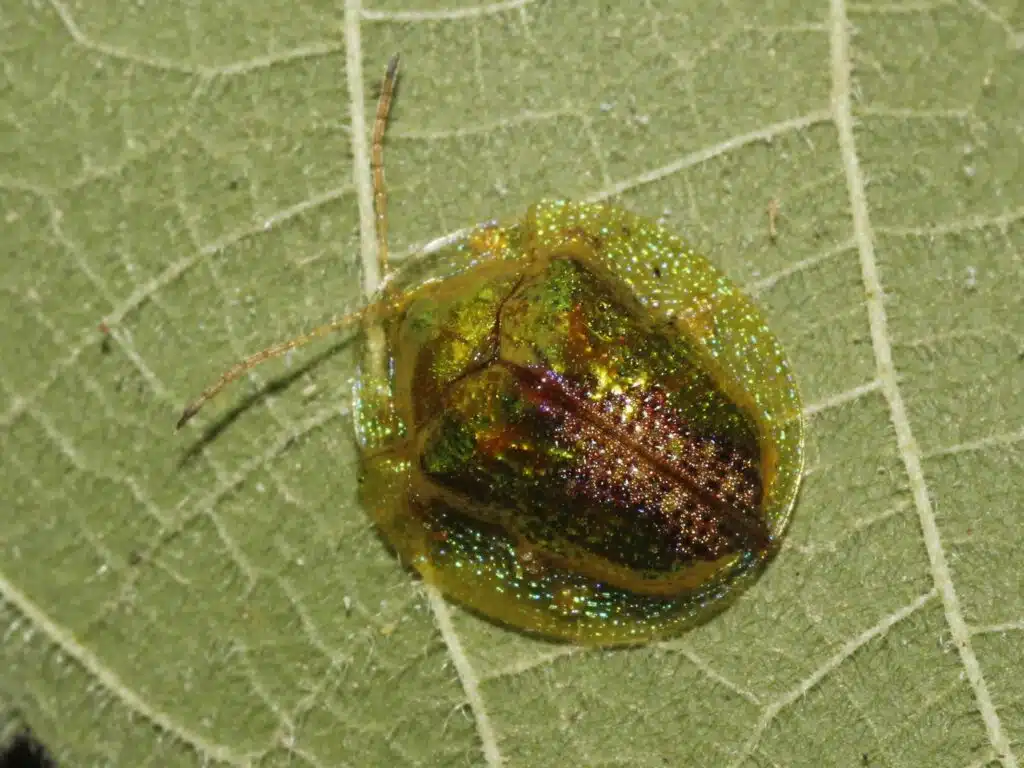
The Anacua Tortoise beetle (Coptocycla texana) gets its name from its shape and the plant it feeds on.
Diet-wise, these beetle only eat Anacua genus flowers and their leaves. They sometimes eat the stems of young Anacua plants.
These are a type of plant mostly found in Southern Texas and nowhere else in the US as they’re native to Mexico.
The beetle has a flattened shape that resembles the shape of a turtle.
Its color is mostly green with golden-yellow overlays. Its iridescent coloring allows this species to either appear dominantly golden or dominantly-green depending on how it reflects light.
43. Purple Tiger Beetle
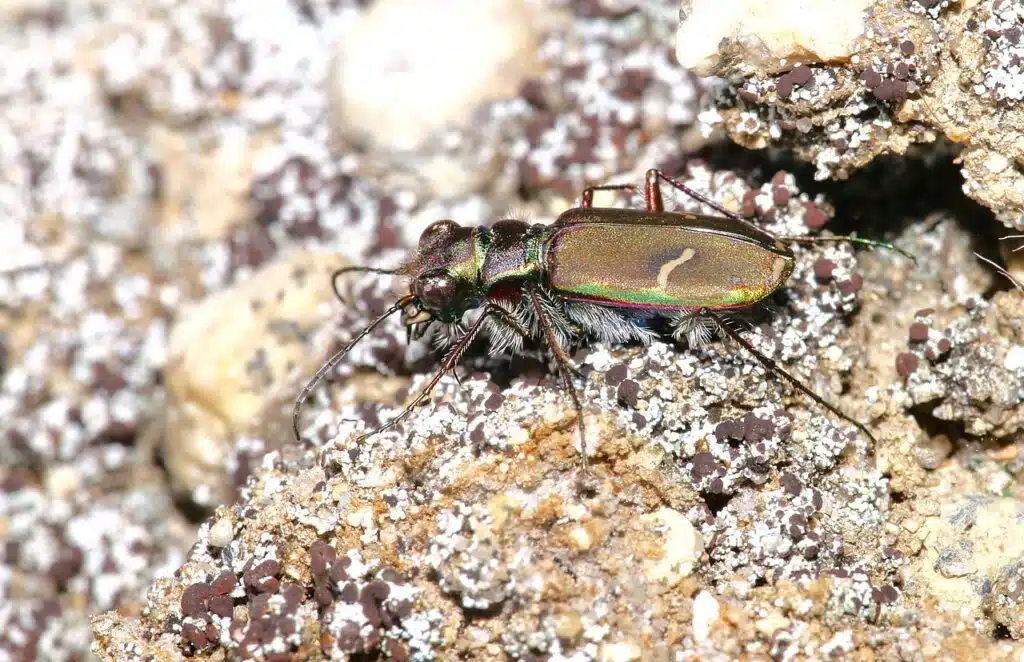
The Purple Tiger beetle (Cicindela purpurea) is a common sight in open forests terrain as well as on soil with little vegetation.
It has a dark green body color that appears uniform across the elytra, thorax, and head.
Like many tiger beetles, the Purple Tiger Beetle also has marks or spots on the elytra.
There are only 2 light green spots with brown borders on the elytra, unlike other tiger beetles which have many more spots which are even larger.
Beetles of this genus have green forelegs and green-brown rear legs.
44. Northern Corn Rootworm
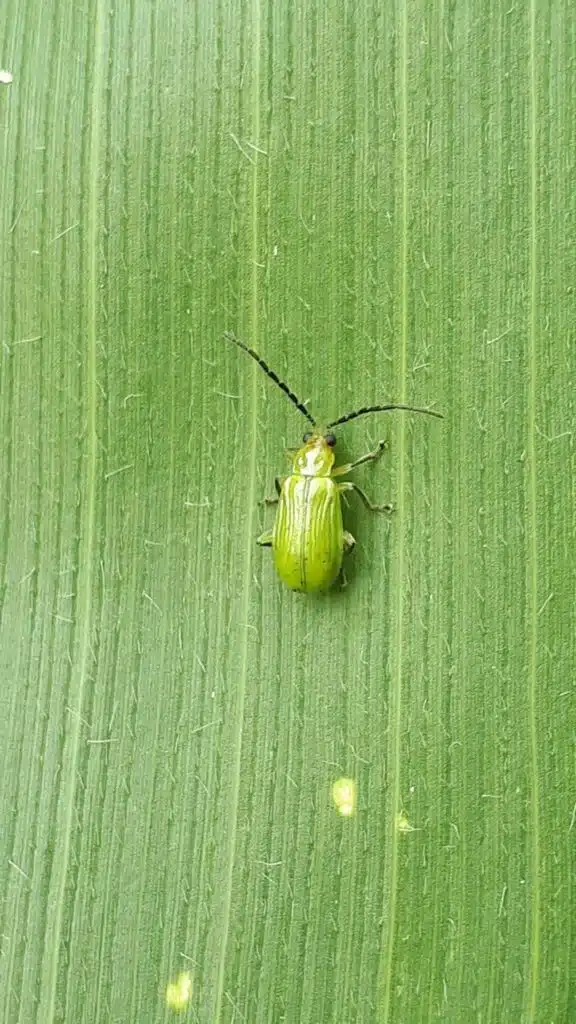
This common green beetle (Diabrotica barberi) is one of the major green pest bugs in the US.
Northern Corn Rootworm beetles are a species that eat corn. They always lay eggs right next to the corn plant they feed on.
Eggs turn into larvae and their larvae start to eat the roots of corn.
It’s estimated that the economic losses caused by the species are considerable in North America, one of the largest producers of corn in the world.
One of the few non-chemical methods of eliminating this beetle from crops is crop rotation.
Farmers choose to plant corn elsewhere each year so that the larvae that live in the ground cannot develop and eat corn once again as they overwinter in the soil.
45. Boreal Long-lipped Tiger Beetle
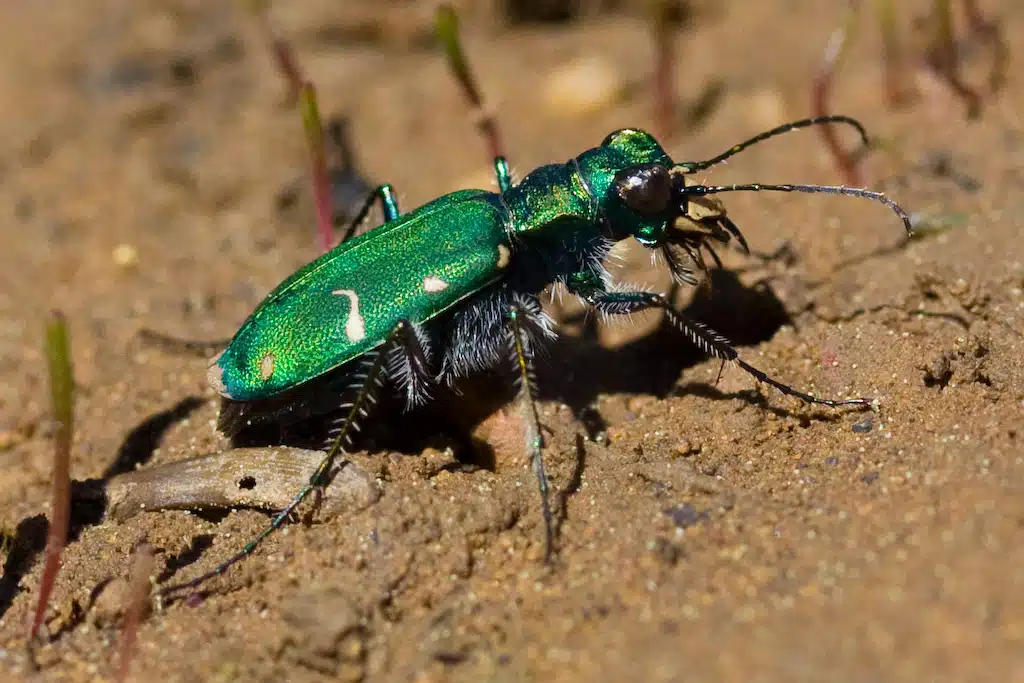
The Boreal Long-lipped Tiger beetles (Cicindela longilabris) live among rocks on rocky terrain.
Beetles of this genus have a metallic green color that shines in direct sunlight.
The elytra have a dark green color on the bottom and a light green color towards the thorax.
3 white or cream marks are seen on each side of the elytra.
The thorax of the species has a dark green color, as does its head.
These beetles are known to absorb certain toxins they can use to keep predators at a safe distance.
46. Splendid Tiger Beetle
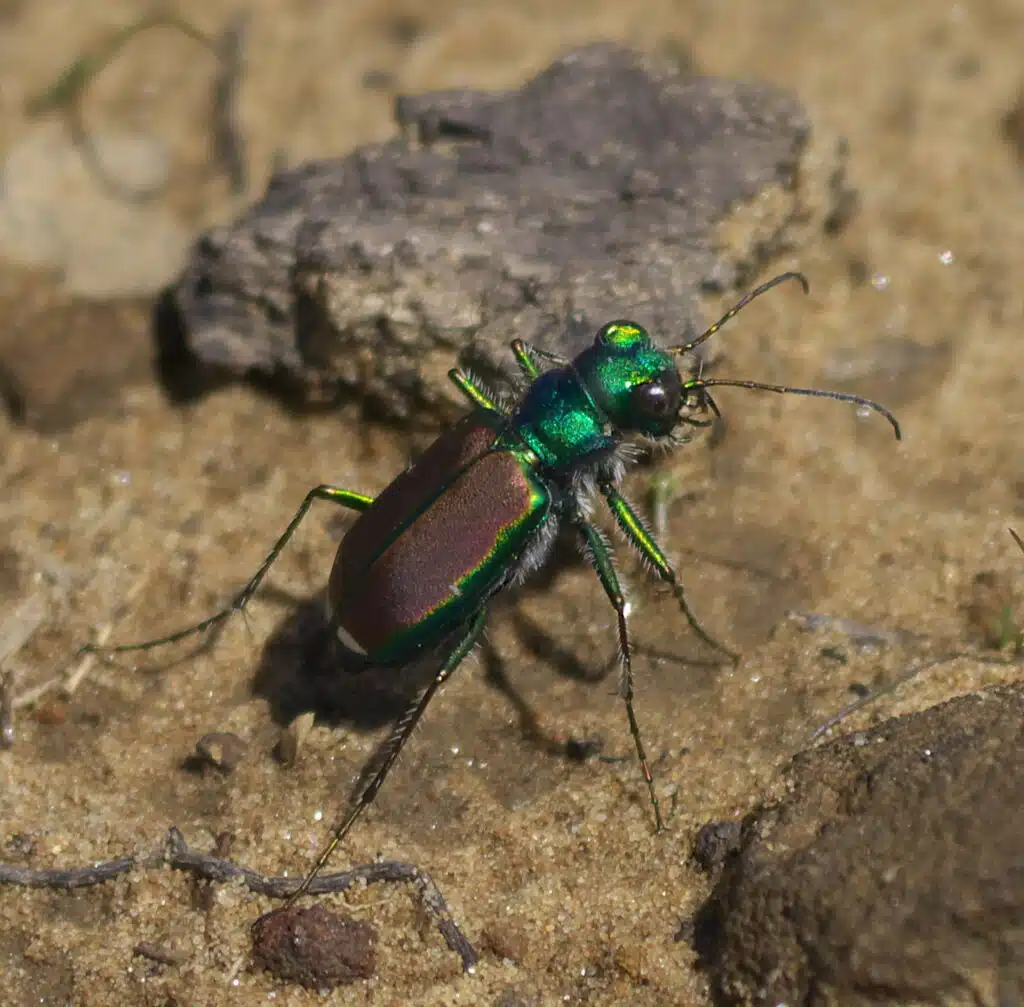
Common on the East Coast, the Splendid Tiger beetle (Cicindela splendida) gets its name from its multicolored body.
Tiger beetles of this genus have orange-red elytra with white marks and dots.
The thorax and the head of the species have a metallic green color that shines in direct sunlight.
Its legs are green.
Short white hairs are seen on the green legs of the species.
Common in the Eastern half of the US, the species is seasonally arising in the spring after overwintering as larvae in the ground.
Further Reading: